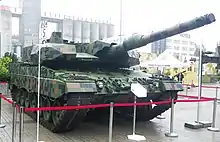Leopard 2
The Leopard 2 is a main battle tank developed by Krauss-Maffei in the 1970s for the West German Army. The tank first entered service in 1979 and succeeded the earlier Leopard 1 as the main battle tank of the German Army. It is armed with a 120 mm smoothbore cannon, and is powered by a V-12 twin-turbo diesel engine. Various versions have served in the armed forces of Germany and 12 other European countries, as well as several non-European nations, including Canada, Chile, Indonesia, Singapore, and Turkey. The Leopard 2 was used in Kosovo with the German Army, and has seen action in Afghanistan with the Dutch, Danish and Canadian contributions to the International Security Assistance Force, as well as seeing action in Syria with the Turkish Armed Forces.
| Leopard 2 | |
|---|---|
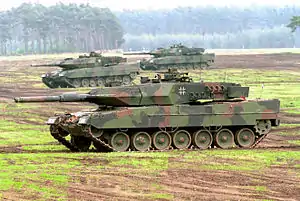 Leopard 2A5s of the German Army (Heer) | |
| Type | Main battle tank |
| Place of origin | West Germany |
| Service history | |
| In service | 1979–present[1] |
| Used by | See Operators |
| Wars | War in Afghanistan Syrian Civil War |
| Production history | |
| Designer | Krauss-Maffei |
| Designed | 1970s |
| Manufacturer | Krauss-Maffei Wegmann Maschinenbau Kiel |
| Unit cost | 2A6: US$5.74 million (2007)[2] |
| Produced | 1979–present |
| No. built | 3,600[3] |
| Variants | See Variants |
| Specifications | |
| Mass | 2A6: 62.3 tonnes (68.7 short tons) |
| Length | 2A6: 9.97 metres (393 inches) (gun forward) |
| Width | 2A6: 3.75 m (148 in) |
| Height | 2A6: 3.0 m (120 in) |
| Crew | 4[1] |
| Armour | 2A6: 3rd generation composite; including high-hardness steel, tungsten and plastic filler with ceramic component. |
Main armament | 1× 120 mm Rheinmetall L/44 or L/55 smoothbore gun[1] (42 rounds) |
Secondary armament | 2× 7.62 mm MG3A1[1] or 2×7.62 mm FN MAG (4,750 rounds) |
| Engine | MTU MB 873 Ka-501 liquid-cooled V12 twin-turbo diesel engine 1,500 PS (1,479 hp, 1,103 kW) at 2,600 rpm |
| Power/weight | 24.1 PS/t (17.7 kW/t) |
| Transmission | Renk HSWL 354 |
| Suspension | Torsion bar suspension |
| Fuel capacity | 1,200 litres (264 imperial gallons; 317 US gallons)[4] |
Operational range | Road: 400 km (250 mi) Cross country: 240 km (150 mi)(internal fuel) |
| Maximum speed | 68 km/h (42 mph)[5] |
There are two main development batches of the tank: the original models up to Leopard 2A4, which have vertically faced turret armour, and the improved batch, namely the Leopard 2A5 and newer versions, which have angled arrow-shaped turret appliqué armour together with other improvements. All models feature digital fire control systems with laser rangefinders, a fully stabilised main gun and coaxial machine gun, and advanced night vision and sighting equipment (first vehicles used a low-light level TV system or LLLTV; thermal imaging was introduced later on). The tank has the ability to engage moving targets while moving over rough terrain.
History
Development
Even as the Leopard 1 was just entering service, the German military was interested in producing an improved tank in the next decade. This resulted in the start of the MBT-70 development in cooperation with the United States beginning in 1963.[6] However already in 1967 it became questionable whether the MBT-70 would enter service at any time in the foreseeable future. Therefore, the German government issued the order to research future upgrade options of the Leopard 1 to the German company Porsche in 1967.[7] This study was named vergoldeter Leopard (Gilded Leopard) and focused on incorporating advanced technology into the Leopard design. The projected upgrades added an autoloader, a coaxial autocannon and an independent commander's periscope.[8] The anti-air machine gun could be operated from inside the vehicle and a TV surveillance camera was mounted on an extendable mast. The shape of the turret and hull was optimised using cast steel armour, while the suspension, transmission and the engine exhaust vents were improved.[9]
Prototype development
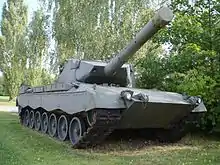
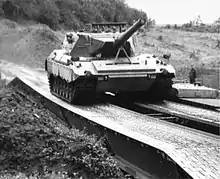
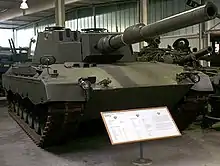
Following the end of the Gilded Leopard study in 1967, the West-German government decided to focus on the Experimentalentwicklung (experimental development) in a feasibility study and to develop new components for upgrading the Leopard 1 and for use on a future main battle tank programme.[8] At first 25 million DM were invested, but after the industry came to the conclusion that with such a low budget the development of the two projected testbeds was not possible, a total of 30 to 32 million DM was invested. The experimental development was contracted to the company Krauss-Maffei, but with the obligation to cooperate with Porsche for the development of the chassis and with Wegmann for the development of the turret. Two prototypes with differing components were built with the aim to improve the conception of the Leopard 1 in such a way that it would match the firepower requirements of the MBT-70. A high first-hit probability at ranges of 2,000 metres (6,600 ft) and the ability to accurately engage targets on the move using a computerised fire control system were the main goals of the experimental development. The resulting vehicles were nicknamed Keiler ("tusker"). Two prototypes (ET 01 and ET 02) of the Keiler were built in 1969 and 1970, both of them being powered by the MB 872 engine.[10]
The MBT-70 was a revolutionary design, but after large cost overruns and technological problems, Germany withdrew from the project in 1969. After unsuccessful attempts of saving the MBT-70 by conceptual changes in order to eliminate the biggest issue—the driver being seated in the turret—it became clear in late 1969 that Germany would stop the bi-national development.[9] The assistant secretary of the military procurement division of the German Ministry of Defence suggested reusing as much technologies developed for the MBT-70 as possible in a further programme, which was nicknamed Eber ("boar") due to his being named Eberhardt. The Eber used a modified MBT-70 turret and hull, with the driver being seated in the hull. Only a wooden mock-up was made.
One year later, a choice was made to continue the development based on the earlier Keiler project of the late 1960s, instead of finishing the development of the Eber. In 1971, the name of the design was determined as Leopard 2 with the original Leopard retroactively becoming the Leopard 1, and Paul-Werner Krapke became the project officer of the Leopard 2 program.[11] Originally two versions were projected: the gun-armed Leopard 2K and the Leopard 2FK, which would be armed with the XM150 gun/launcher weapon of the MBT-70.[12]
That year 17 prototypes were ordered, but only 16 hulls were built as the production of hull PT12 was cancelled. Ten were ordered initially before another seven were ordered. The 17 turrets were designated T1 to T17, and the hulls were designated PT1 to PT11 and PT13 to PT17. To test a larger number of components and concepts, each prototype was fitted with components not found on the other prototypes. Ten of the turrets were equipped with 105 mm smoothbore guns, and the other seven prototypes were equipped with a 120 mm smoothbore gun.[12][13] Hulls PT11 and PT17 were fitted with a hydropneumatic suspension based on the MBT-70 design.[12] The running gears of these two hulls had only six road wheels. Different types of APUs were mounted in the prototypes. All turrets were equipped with a machine gun for air defence except the turret mounted on PT11, where a 20 mm remotely operated autocannon was mounted. With the exception of hulls PT07, PT09, PT15 and PT17, all prototypes used the MB 873 engine. The road wheels were taken from the MBT-70 and the return rollers from the Leopard 1.[12] The prototypes were designed with a projected weight of MLC50, which equals approximately 47.5 tonnes (46.7 long tons; 52.4 short tons). The welded turret utilised spaced armour formed by two steel plates.[14] The prototypes were equipped with an EMES-12 optical rangefinder and fire control system, which later was adopted on the Leopard 1A4.
In mid-1973 a new turret was designed by Wegmann saving 1.5 tonnes (1.5 long tons; 1.7 short tons) weight.[15] It was nicknamed the Spitzmaus-Turm (shrew turret) due to the highly sloped front. This design was only possible with the new EMES-13 optical rangefinder, which required a base length of only 350 millimetres (14 in) instead of the previous 1,720 millimetres (68 in).[14] Based on experiences in the Yom Kippur War, a higher level of protection than the prototypes' heavily sloped spaced armour was demanded in late 1973 and the Spitzmaus-Turm was never produced.[16] The weight limit was increased from MLC50 to MLC60, which equals approximately 55 tonnes (54 long tons; 61 short tons). The turret T14 was modified to test a new armour configuration, taking on a blockier-looking appearance as a result of using vertical modules of spaced multilayer armour. It was also used to test the new EMES-13 optical rangefinder. The modified turret T14 was designated T14 mod.[16] and was fitted with a fully electric turret drive and stabilization system, which was developed together by the companies General Electric and AEG Telefunken.
Leopard 2AV
In July 1973 German Federal Minister of Defence Georg Leber and his US counterpart James R. Schlesinger agreed upon a higher degree of standardization in main battle tanks being favourable to NATO. By integrating components already fully developed by German companies for the Leopard 2, the costs of the XM1 Abrams, U.S. prototype tank developed after the MBT-70, should be reduced. A German commission was sent to the US to evaluate the harmonisation of components between the XM1 and Leopard 2.[17] However, by American law it was not possible for a public bidder to interfere in a procurement tender after a contract with intention of profits and deadline was awarded to companies of the private industry.[17]
As a result, the modification of the Leopard 2 prototypes in order to meet the US Army requirements was investigated. Following a number of further talks, a memorandum of understanding (MOU) was signed on 11 December 1974 between the Federal Republic of Germany and the United States of America, which declared that a modified version of the Leopard 2 should be trialled by the US against their XM1 prototypes,[18] after the Americans had bought and investigated prototype PT07 in 1973.[19] The MOU obligated the Federal Republic of Germany to send a complete prototype, a hull, a vehicle for ballistic tests and a number of special ballistic parts to the US, where they would be put through US testing procedures for no additional costs.[20]
The Leopard 2AV (austere version) was based on the experiences of the previous Leopard 2 development. It was created in order to meet the US requirements and the latest protection requirements of the German MoD. The turret T14 mod was used as base for the Leopard 2AV's turret, but meeting the required level of protection for the hull required several attempts until the final ballistic trials on 23 to 26 June 1976.[21] Following the US' preference of laser rangefinders, the turret of prototype PT19 was fitted with a laser rangefinder developed together with the American company Hughes.[22] In comparison with the earlier Leopard 2 prototypes, the fire control system was simplified by replacing the EMES-12 optical rangefinder and removing the crosswind sensor, the air-pressure and temperature sensors, the powder temperature sensor, the PERI R12 commander sight with IR searchlight, the short-range grenade launcher for use against infantry, the retractable search-light, the spotlight, the retractable passive night vision sight, the APU and the mechanical loading assistant.[20]
Due to the design and production of the Leopard 2AV taking more time than expected, the shipment to the US and the US evaluation was delayed. It was not possible to test the Leopard 2AV before 1 September 1976.[21] Despite the German wish that the Leopard 2AV and the XM1 prototypes would be evaluated at the same time, the US Army decided not to wait for the Leopard 2AV and tested the XM1 prototypes from Chrysler and General Motors beforehand.[17][23]
Two new prototype hulls and three turrets were shipped to the US: PT20 mounting a 105 mm rifled L7 gun and a Hughes fire control system, PT19 with the same fire control system but able to swap out the gun for the 120 mm Rheinmetall smoothbore gun, and the PT21 fitted with the Krupp Atlas Elektronik EMES-13 fire control system and the 120 mm Rheinmetall gun.[19] The Leopard 2AV fully met the US requirements.[24] A study made by the American FMC Corporation showed, that it was possible to produce the Leopard 2AV under licence in America without exceeding the cost limits set by the US Army.[24] But already before the trials were finished, it was decided that instead of the US Army possibly adopting the Leopard 2AV, the focus was shifted on the commonization of components between the two tanks. FMC, after having acquired the licences for production of the Leopard 2AV, decided not to submit a technical proposal, as they saw little to no chance in the US Army adopting a vehicle not developed in the US.[23]
The US Army evaluation showed that on the XM1 a larger portion of the tank's surface was covered by special armour than on the Leopard 2AV.[23] Differences in armour protection were attributed to the different perceptions on the expected threats and the haste in which the Leopard 2AV was designed to accommodate special armour.[23] On mobility trials the Leopard 2AV performed equal to better than the XM1 prototypes. The AGT-1500 gas turbine proved to consume about 50% more fuel[25] and the Diehl tracks had a higher endurance, while the tracks used on the XM1 prototypes failed to meet the Army's requirements.[24] The heat signature of the MTU diesel engine was much lower.[25] The fire control system and the sights of the Leopard 2 were considered to be better and the 120 mm gun proved to be superior.[23] The projected production costs for one XM1 tank were $728,000 in 1976, the costs for one Leopard 2AV were $56,000 higher.[23]
After the American evaluation of the Leopard 2AV and the US army's decision to opt for the XM1 Abrams, both American and German sources blamed the other side. According to American literature it was discovered, that the Leopard 2AV prototype used for mobility trials was underweight.[nb 1]
In Germany the test conditions were criticised for being unrealistic and favouring the XM1. Instead of using actual performance data, the calculated hypothetical acceleration was used.[25] The XM1 was found to have a slightly higher rate of fire despite having internal layouts similar to the Leopard 2AV, because the XM1 prototypes were manned by professional crews, while the Leopard 2AV had to be manned by conscripts in order to prove that the Leopard 2AV was not too complicated.[25] Firing on the move was demonstrated on flat tracks, which nullified the better stabilization systems of the Leopard 2AV.[25]
Series production

The decision to put the Leopard 2 tank in production for the German army was made after a study was undertaken, which showed that adopting the Leopard 2 mod would result in a greater combat potential of the German army than producing more Leopard 1A4 tanks or developing an improved version of the Leopard 1A4 with 105/120 mm smoothbore gun, improved armour protection, a new fire control system and a 1,200 horsepower (890 kW) or 1,500 horsepower (1,100 kW) engine.[26] Various changes were applied to the Leopard 2 design before the series production started.[27][28] Engine, transmission and suspension were slightly modified and improved. The ballistic protection of turret and hull was improved and weak spots were eliminated. The turret bustle containing the ready ammunition racks and the hydraulic systems was separated from the crew compartment and fitted with blow-out panels. The development of several new components introduced to the Leopard 2 during the Leopard 2AV development and after the US testing was completed. For the series version the Hughes-designed laser rangefinder made with US Common Modules was chosen over the passive EMES-13 rangefinder. The EMES-13 system was considered to be the superior solution, but the Hughes system was cheaper and fully developed.[29]
The German company Krupp-Atlas-Elektronik acquired the licence of the Hughes design and modified it to meet the needs of the German army.[29] The modified rangefinder received the designation EMES-15. The installation of the US Honeywell AGT1500 in the Leopard 2 was tested by MaK.[24] The AGT-1500 was borrowed from the United States and required deep modifications of the Leopard 2's chassis. However, driving tests at the WTD 41 revealed a number of drawbacks such as high fuel consumption and the lacking performance of the transmission including the brakes.[24] This project was thus terminated.
In January 1977 Germany ordered a small pre-series of three hulls and two turrets which were delivered in 1978. These vehicles had increased armour protection on the front of the hull. One of the hulls was fitted with the earlier turret T21 and was used by the German army school in Munster for troop trials until 1979.[30] In September 1977, 1,800 Leopard 2 tanks were ordered, to be produced in five batches. The main contractor was Krauss-Maffei, but Maschinenbau Kiel (MaK) was awarded a contract for producing 45% of the tanks. The first batch consisted of 380 tanks. The delivery of six tanks was scheduled for 1979, 114 for 1980, 180 for 1981 and 300 tanks each following year.[31]
The first series tank was delivered on 25 October 1979. By 1982 the first batch of 380 Leopard 2 tanks was completed. 209 were built by Krauss-Maffei (chassis no. 10001 to 10210) and 171 by MaK (chassis no. 20001 to 20172). The first production tanks were fitted with the PzB-200 image intensifier due to production shortages of the new thermal night-sight system, which was later retrofitted to the earlier models. After the original five batches, three further batches of Leopard 2 tanks were ordered, increasing the amount of Leopard 2 tanks ordered by Germany to a total of 2,125.[32] The sixth batch was ordered in June 1987 and consisted of 150 tanks, which were produced between January 1988 and May 1989. The seventh batch of 100 tanks was produced between May 1988 and April 1990. The last batch for the German army totalling 75 tanks was produced from January 1991 to March 1992.[32]
Further improvements
While previous models only varied in detail, the Leopard 2A4 introduced a digital ballistic computer and an improved fire extinguishing system. Starting within the sixth batch tanks were fitted with an improved armour array and new side skirts. In 1984 the German military procurement agency stated a number of requirements for a future Leopard 2 upgrade. In 1989, the Kampfwertsteigerung (combat potential increasement) programme was initiated in Germany with the delivery of first prototypes. The official military requirements were published in March 1990.[33] The KWS programme was projected to consist of three stages. The first stage of the KWS programme replaced the Rheinmetall 120 mm L/44 gun barrel and the corresponding gun mount with a longer barrelled and more lethal L/55 version.[33] This stage was adopted in form of 225 Leopard 2A6 tanks starting in 2001 and a lasting to 2005.[34] The KWS stage 2 focused on improvements of armour protection and survivability, it was adopted in form of the Leopard 2A5 starting in 1995. The base armour of the tank was exchanged and additional armour modules were installed at the turret. A first batch of 225 Leopard 2 tanks was upgraded to Leopard 2A5 configuration between 1995 and 1998, a second batch of 125 followed 1999 to 2002.[35]

In the third stage of KWS was the planned replacement of the Leopard 2 turret by a new turret fitted with a 140 mm NPzK tank gun, an autoloader and the IFIS battlefield management system.[33] The ballistic protection at the hull was to be improved.[33] Originally a total requirement for 650 Leopard 2 tanks with KWS 3 was projected.[34] It was never finalised, but the 140 mm NPzK tank gun was tested on an older prototype. In 1995 it was decided to cancel due to changes in the political environment. The funds were redirected to the NGP project of the German army. The Leopard 2A6M was developed with an enhanced mine-protection kit providing protection against mines that can detonate below the hull (like mines with bending wire trigger) and EFP mines.[34] The weight of the Leopard 2A6M is 62.5 tonnes.[36]
The latest version of the tank is the Leopard 2A7, which entered service in a small initial batch of 20 tanks in 2014.[37] Already before the first Leopard 2A7 tank was handed over to the German Army, plans for future upgrades were already made.[38] At this time an "extensive" increase in combat value while retaining the original mobility of the Leopard 2 was planned.[38] The optics of the tank also will be improved.[38]
In April 2015, Welt am Sonntag claimed that tungsten (wolfram) rounds used in Leopard 2 cannot penetrate the Russian T-90, nor the modernized version of T-80. They also stated that the German military will develop a new improved round, but it will be exclusively developed for the Leopard 2A7.[39]
In 2015 Rheinmetall disclosed that it is developing a new 130 mm smoothbore gun for the Leopard 2 tank and its successor. This gun will offer a 50% increase in performance and penetration. Marketing for the new gun was slated to begin in 2016.
Replacement
The Leopard 2 first entered service in 1979, and its service life is anticipated to end around 2030. In May 2015, the German Ministry of Defence announced plans to develop a tank jointly with France as a successor to both the Leopard 2 and Leclerc tanks. Technologies and concepts will be investigated to determine what capabilities are needed in a future tank.[40] Deployment of the new tank, titled Main Ground Combat System (MGCS), will be preceded by incremental upgrades to the Leopard 2, including a new digital turret core system and situational awareness system and an Active Protection System (APS). A short-term lethality increase will come from a higher pressure 120 mm gun firing new ammunition, expected to deliver 20 percent better performance than the L/55. Mid-term efforts will focus on a Rheinmetall 130 mm cannon concept offering 50 percent better armour penetration. With the Russian T-14 Armata being equipped with the Afghanit, an Active Protection System designed to mitigate the effectiveness of ATGM, more importance is being placed on direct fire weapons.[41]
Exports
Germany has fielded about 2,125 Leopard 2 main battle tanks in various versions, but most of the tanks were sold following the German reunification. Other countries bought newly or locally built tanks.
The Netherlands ordered 445 Leopard 2 tanks on 2 March 1979, after examining the results of the Leopard 2AV in the United States.[42] It became the first export customer of the Leopard 2 and the vehicles were delivered between July 1981 and July 1986. The Swiss army decided to purchase Leopard 2 tanks over the M1A1 Abrams after trialling both tanks between August 1981 and June 1982. The Swiss decision was made on 24 August 1983 and the funding was subsequently approved by the government in 1984.[43] Thirty-five of the tanks were delivered by Kraus-Maffei by June 1987; Eidgenössische Konstruktionswerkstätte Thun started license production of 345 additional vehicles in December 1987.
The Leopard 2 became very popular in the 1990s, when the shrinking German army offered many of its redundant Leopard 2s at a reduced price. It became successful enough in Europe that the manufacturer started calling it the Euro Leopard, despite France, Britain, and Italy all operating their own MBTs. But with further non-European orders, the name "Global-Leopard" is now used instead.[44]
After investigating the option of a locally developed replacement for the Strv 103 tank, Sweden decided to buy a foreign tank model. The Leopard 2 Improved (Leopard 2A5 prototype) won the competition against the M1A2 Abrams and the French Leclerc; after intensive test from January 1994 to June 1994, the Swedish military opted for the Leopard 2.[45] The Swedish military also evaluated the Soviet T-80U tank, but separately from the other tanks. The Swedish military found the Leopard 2 Improved to meet the military demands by 90%.[45] The M1A2 only met the Swedish requirements by 86%, whereas the Leclerc met 63%. Sweden contracted on 20 June 1994 the production of 120 Stridsvagn 122 (Swedish Leopard 2A5 subvariant) with many components being made locally. The first Stridsvagn 122 was delivered on 19 December 1996. Sweden also leased and later bought a total of 160 Leopard 2A4 tanks in 1994 and 1995; the first vehicle was delivered in February 1994.[45]
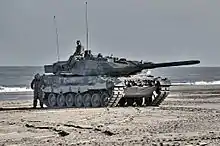
Denmark bought 51 ex-German Leopard 2A4 tanks after the Danish military school, the Haerens Kampskole, recommended to base the adoption of a new tank on the Swedish army trials. The tanks were delivered in 1997, but the upgrade to Leopard 2A5 level was already decided. In 2004 the Danish army bought another 18 ex-German Leopard 2 tanks.
In 1998, Greece held a competition to determine the main battle tank for the Hellenic army. The Leopard 2 Improved managed to outperform the Challenger 2E, Leclerc, M1A2 Abrams, T-80U and, T-84 and was subsequently chosen by the Greek officials. In March 2003 Greece ordered 170 Leopard 2 tanks of which 140 were locally assembled.[46][47] Greece also bought 183 Leopard 2A4 and 150 Leopard 1 tanks.[48]
Spain initially leased 109 Leopard 2A4 tanks, after Krauss-Maffei withdrew from the Lince development, a special lighter version of the Leopard 2 developed together with Santa Bárbara Sistemas. Before the end of the Lince tank, Spain already had rejected the M1A1 Abrams and the Vickers Valiant tank. After deciding to purchase the leased tanks, Santa Bárbara Sistemas acquired the licence to locally produce 219 Leopard 2A6 tanks for the Spanish army.[49]
Poland received 128 Leopard 2A4 tanks from German army stocks in 2002. In 2013 Poland ordered a further 119 ex-German Leopard 2s. Finland bought 124 used Leopard 2A4 tanks and six armoured bridge-layer Leopard 2L tanks from Germany in 2002 and 2003. The tanks served as replacement for the old Soviet-made T-55 and T-72M1. The Netherlands resold 114 of their tanks (and one turret) to Austria, 80 to Canada in 2007,[50] another 52 tanks to Norway, 37 to Portugal and finally 100 to Finland.
In 2005, Turkey ordered 298 Leopard 2 tanks from German army stocks.[51] The Leopard 2 was already chosen in 2001 after successfully competing one year earlier in the Turkish army trials against the T-84 Yatagan, Leclerc and a version of the M1A2 Abrams fitted with a German MTU diesel engine. Turkey already wanted to buy 1,000 Leopard 2 tanks in 1999, but the German government rejected such deal.
Singapore bought 96 Leopard 2 tanks from Germany in 2006.[52] Chile bought 172 ex-German Leopard 2A4 tanks and 273 Marder 1A3 IFVs in 2007.
Indonesia ordered 103 Leopard 2 tanks and 42 Marder 1A3 IFVs in 2013.[53] At first the export of heavy weapons to Indonesia was not allowed by the German government, due to the questionable human rights record of Indonesia. 61 of the 103 Leopard 2 tanks will be upgraded by Rheinmetall to the Leopard 2RI standard, based on Rheinmetall's Revolution modular upgrade concept.[54]
Qatar ordered 62 Leopard 2A7 tanks and 24 Panzerhaubitze 2000s in 2013[55] The delivery of the tanks started in late 2015 and the first tanks were displayed on a military parade on 18 December 2015.[56]
Saudi Arabia has shown interest in buying the Leopard 2 since the 1980s. However, due to the political circumstances and the questionable situation of human rights in Saudi Arabia, no deal was made. Saudi Arabia renewed its intention of buying Leopard 2 tanks in 2011.[57] While earlier news reports suggested an interest in buying about 200 tanks, later reports revealed an increased order of 600 to 800 tanks.[57] The German government at first approved the deal, but canceled it later due to human rights concerns and Saudi Arabia's military intervention in Bahrain.[57][58]
The Leopard 2 was also tested by the United Kingdom. In 1989 the Leopard 2 was evaluated as possible replacement for the Challenger 1 tank.[59] Ultimately the British armed forces decided to adopt the locally made Challenger 2. The Australian Army evaluated ex-Swiss Army Leopard 2s as a replacement for its Leopard 1AS tanks in 2003, but selected the M1A1 AIM instead due to easier logistics. More modern versions of the Leopard 2 or M1 Abrams, such as the Leopard 2A6 were not considered due to their higher price.[60]
In December 2018, Hungary placed an order for 44 Leopard 2A7+s and 12 second-hand 2A4s. The order coincided with the procurement of 24 Panzerhaubitze 2000, and is expected to replace Hungary's current fleet of T-72 tanks "no sooner than 2020".[61][62]
KFOR
Starting on 12 June 1999, 28 Leopard 2A5 tanks were deployed by the German army as part of the Kosovo Force (KFOR) to Kosovo. The vehicles of Panzerbataillon 33 and 214, were sent from Macedonia to Prizren. They were used for patrols, protecting checkpoints and bases as well as part of the show of force. On 13 June 1999, two members of the Serbian paramilitary started firing from inside a Fiat 125p car at one of the checkpoints in Prizren. A Leopard 2A5 was located at the checkpoint, but it could not participate in the fighting as it was only partially crewed.[63] On 26 June 1999, a Leopard 2A5 fired four warning shots above the town of Orahovac.[64] At the end of 2000 and beginning of 2001, the tanks were replaced by the Leopard 2A4 model. Leopard 2A4s were deployed to Macedonia during 2001 as part of the NATO intervention. The tanks served to protect Bundeswehr logistic sites in Macedonia. Until their return in 2004, the Leopard 2 tanks were stationed at the Austrian-Swiss camp "Casablanca".[64]
IFOR/SFOR
The Dutch contingent in Bosnia-Hercegovina operated Leopard 2 tanks.[65] Dutch Leopard 2A4s and Leopard 2A5s at the NLD bases at Bugojno, Novi Travnik, Sisava, Knezevo, Maslovare and Suica.
ISAF/OEF
In October 2003, Canada was planning to replace its Leopard C2s with wheeled Stryker Mobile Gun Systems. However, operational experience in Afghanistan, and in particular during Operation Medusa, convinced the Canadian military of the usefulness of maintaining a tank fleet.[66] Leopard C2s were deployed to Kandahar in December 2006,[67] but they were by then almost 30 years old, and were nearing the end of their operational life. The Canadian government decided to borrow 20 Leopard 2A6s and three armoured recovery vehicles from Germany for rapid deployment to Afghanistan. In late August 2007, the first Leopard 2s were airlifted into Afghanistan to equip Lord Strathcona's Horse (Royal Canadians).[68]
In an assault on 2 November 2007, a Leopard 2A6M hit an IED and survived without casualties: "My crew stumbled upon an IED (improvised explosive device) and made history as the first (crew) to test the (Leopard 2A6) M-packet. It worked as it should." wrote a Canadian officer in an email to German defence officials.[69] Canadian Chief of the Defence Staff General Rick Hillier denied reports that a Leopard 2 tank that was struck by an IED was a write-off, insisting that the tank has been repaired and is once again in use. "The Taliban have been engaged with some of the new Leopard 2 tanks in several ambushes" and that as a result the Taliban "learned some very harsh lessons" and lost the battle in question "very quickly and very violently."[70]
In October 2007, Denmark also deployed Leopard 2A5 DKs in support of operations in southern Afghanistan. The Danish tank unit, drawn from the first battalion of the Jydske Dragonregiment (Jutland Dragoons Regiment),[71] was equipped with three tanks and one M113 armoured personnel carrier, with an armoured recovery vehicle and another tank kept in reserve.[72] The Danish version of the Leopard 2A5 is fitted with Swedish-made Barracuda camouflage mats, that limit the absorption of solar heat, thus reducing infrared signature and interior temperature.[71] It also has a conventional driver's seat bolted on the floor of the tank, wherereas in the Canadian 2A6M (as part of the mine-protection package) the driver's seat has been replaced by a "Dynamic Safety Seat",[73] which is a parachute-harness like arrangement that the driver wears around his hip; in this way, the driver does not have any contact with the hull except on the pedals and is out of the shockwave area of exploding land mines or IEDs.
In January 2008, Danish tanks halted a flanking manoeuvre by Taliban forces near the Helmand River by providing gunfire in support of Danish and British infantry from elevated positions.[74] On 26 February 2008, a Danish Leopard 2 was hit by an explosive device, damaging one track. No one was injured and the tank returned to camp on its own for repairs.[75] The first fatality suffered by a crew operating a Leopard 2 happened on 25 July 2008. A Danish Leopard 2A5 hit an IED in Helmand Province. The vehicle was able to continue 200 metres (656 ft) before it halted. Three members of the four-man crew were able to escape even though wounded, but the driver was stuck inside. On site treatment by Danish medics could not save him. The vehicle was towed to FOB Attal and then later to FOB Armadillo for investigation and possible redeployment. During the same contact with Taliban forces, a second tank was caught in an explosion but none of the crew were wounded.[76] Beginning on 7 December 2008, Leopard 2 tanks took part in Operation Red Dagger, firing 31 rounds in support of Coalition troops as they recaptured Nad Ali District. A press release from the British Ministry of Defence praised the tank's fire accuracy and mobility, claiming the Leopard 2 was a decisive factor in the coalition's success. Danish Leopard 2A5s are, as of 2013, still in Afghanistan, providing security cover for the withdrawal of British and NATO troops.[77]
Turkish intervention in Syria
Turkey operates 354 Leopard 2A4 tanks. Initially using other tank types including upgraded M60s, in December 2016 Turkey deployed a number of Leopard 2A4s to the Syrian Civil War against Islamic State of Iraq and the Levant (ISIS) as part of Operation Euphrates Shield. Initially, three of the Turkish Leopard 2A4s operating in Syria were destroyed or damaged by ISIS using anti-tank missile systems (possibly Fagot or Konkurs anti-tank guided missiles obtained from Syrian or Iraqi Army captured stocks). In mid-December 2016, two 2A4 tanks were captured by ISIS near al-Bab city in Syria during Euphrates Shield operations; Amaq News Agency posted video of the captured vehicles.[78] By late December 2016, Islamic State had captured or incapacitated 10 Leopard 2A4s. Some of the 10 were damaged by IEDs, while the rest were damaged by anti-tank weapons.[79] This is the largest number of Leopard 2A4 tanks to have been incapacitated in any one conflict.[79][80] Additional ISIS propaganda images and video depicting several completely destroyed Leopards, some with their turrets blown off, were published in January 2017.[81] Tanks which suffered the worst damage may have been destroyed by air strikes in order to prevent capture but sources generally state that the damage was caused solely with anti-tank missiles or car bombs driven by a suicide bomber (also known as suicide vehicle borne improvised explosive devices or SVBIED).[82][83]
In January 2017, the German newspaper Die Welt reported that ISIL fighters used 9M133 Kornet anti-tank missiles to destroy six Leopard 2 tanks used by the Turkish military in Syria.[84]
At least eight Leopard 2 MBT have been destroyed according to photographic reports.[85]
Turkey also confirmed the use of Leopard 2A4 tanks during the Turkish military operation in Afrin to the German government.[86]
Design
Protection
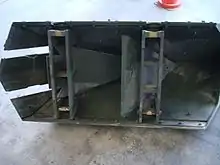
.jpg.webp)
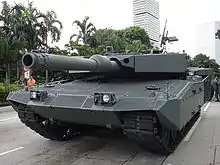
The Leopard 2 uses spaced multilayer armour throughout the design.[87] The armour consists of a combination of steel plates of different hardness, elastic materials and other non-metallic materials.[88][89][90] Steel plates with high hardness and high ductility are used. The armour is a result of extensive research about the formation and penetration mechanism of shaped charge jets.[91] The Leopard 2's armour might be based on the British Burlington armour, which had already been demonstrated to the Federal Republic of Germany in 1970.[92] Later, in the mid-1970s, full details about Burlington were handed over to the West German government. The frontal arc of the Leopard 2's armour is designed to withstand large caliber kinetic energy penetrators and shaped charge projectiles.[90] During the 1980s, it was estimated that the Leopard 2's front would resist 125 mm APFSDS rounds fired from a distance of 1,500 m.[91][93]
The Leopard 2A4's armour has a maximum physical thickness of 800 millimetres (31 in) based on unofficial measurements and estimates made by former conscripts and professional soldiers of the German army.[94] On the Leopard 2A5 and subsequent models, the thickness is increased by the wedge-shaped armour module to 1,500 millimetres (59 in).[94]
The side and the rear of the tank protect against heavy machine guns, medium caliber rounds and older types of tank ammunition. The side of the hull is covered by armour skirts to increase protection against projectiles and RPGs. The frontal third of the hull sides is covered by heavy ballistic skirts, while the rest of the hull sides is covered by steel-reinforced rubber skirts. For increased protection against mines, the sides of the hull floor are sloped by 45° and the floor is reinforced with corrugations.[88]
Secondary protection
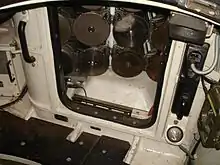
The Leopard 2's design follows the concept of compartmentation; possible sources of fire or explosions have been moved away from the crew.[90] In the turret, the ammunition and the hydraulics are located in compartments separated from the crew. In case of a detonation, the blow-off panels on the compartment roofs will direct the explosion and fire away from the crew. The crew is also protected against nuclear, biological and chemical (NBC) threats, as the Leopard 2 is equipped with a Dräger NBC overpressurization system, which provides up to 4 millibars (4.0 hPa) over-pressure inside the vehicle.[95]
Two groups of four Wegmann 76 mm smoke mortars are mounted on either side of the turret and can be electrically fired either as single rounds or in salvos of four. They are mounted on most Leopard 2 models, with the exception of Dutch Leopard 2s, which are equipped instead with a Dutch-designed smoke mortar system with six barrels on each side.[95] Swedish Stridsvagn 122 utilise French GALIX smoke dispensers, similar to the system found on the French Leclerc.[96]
The Leopard 2 is equipped with a fire protection system. Four 9 kg Halon fire extinguisher bottles are installed on the right behind the driver's station. The bottles are connected to pipes and hoses and are activated automatically by the fire detection system, when temperatures rise above 82 °C (180 °F) inside the fighting compartment, or manually via a control panel in the driver's compartment.[95] An extra 2.5 kg Halon fire extinguisher is stored on the floor beneath the main gun.
Armour upgrades
Following the Leopard 2's introduction into service in 1979, the armour has been gradually improved over the years. A modified version of spaced multilayer armour was introduced beginning with the 97th vehicle of the 6th production batch.[97] The same batch also introduced an improved type of heavy ballistic skirts.
The Leopard 2A5 upgrade focused on increased armour protection. While upgrading a Leopard 2 tank to the Leopard 2A5 configuration, the roof covering the armour modules is cut open and new armour modules are inserted.[98][99] New additional armour modules made of laminated armour are covering the frontal arc of the turret. They have a distinctive arrowhead shape and improve the protection against both kinetic penetrators and shaped charges.[99][100] The side skirts also incorporate improved armour protection.[100] Furthermore, a 25 mm-thick spall liner reduces the danger of crew injuries in case of armour penetration.[95][99]
The Leopard 2A7 features the latest generation of passive armour and belly armour providing protection against mines and IEDs.[101] The Leopard 2A7 is fitted with adapters for mounting additional armour modules or protection systems against RPGs.[102]
For urban combat, the Leopard 2 can be fitted with different packages of modular armour. The Leopard 2A4M CAN, Leopard 2 PSO (Peace Support Operations) and the Leopard 2A7 can mount thick modules of composite armour along the flanks of turret and hull, while slat armour can be adapted at the vehicle rear. The armour modules provide protection against the RPG-7, which depending on the warhead can penetrate between 280 millimetres (11 in) and 600 millimetres (24 in) of steel armour.[103] The Leopard 2A6M CAN increases protection against rocket-propelled grenades (RPGs) by including additional slat armour.[104]
Additional armour packages have been developed by a number of different companies. IBD Deisenroth has developed upgrades with MEXAS and AMAP composite armour, the latter is being used on Singaporean and Indonesian Leopard 2 tanks. RUAG has developed an armour upgrade utilizing their SidePRO-ATR composite armour. This upgrade was first presented on the IAV 2013.[105]
The Leopard 2A4M and 2A6M add an additional mine protection plate for the belly, which increases protection against mines and IEDs.[95]
Armour protection estimates
Estimated levels of protection for the Leopard 2 range from 590–690 mm RHAe on the turret, 600 mm RHAe on the glacis and lower front hull on the Leopard 2A4, to 920–940 mm RHAe on the turret, 620 mm RHAe on the glacis and lower front hull on the Leopard 2A6 against kinetic projectiles.[95]
According to a description page hosted by the Federation of American Scientists, the armour of the Leopard 2A4 is believed to provide protection equivalent to 700 mm armour steel (RHA) against kinetic energy penetrators and 1000 mm RHA against shaped charge warheads.[106]
Armament
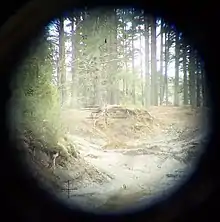
Primary
The primary armament for production versions of the Leopard 2 is the Rheinmetall 120 mm smoothbore gun—the same gun later adapted for use on the M1 Abrams—in either the L/44 variant (found on all production Leopard 2s until the A5), or the L/55 variant (as found on the Leopard 2A6 and subsequent models).[95] Ammunition for the gun comprises 27 rounds stored in a special magazine in the forward section of the hull, to the left of the driver's station, with an additional 15 rounds stored in the left side of the turret bustle, which are separated from the fighting compartment by an electrically operated door.[95] If the ammunition storage area is hit, a blow-off panel in the turret roof would direct an explosion upwards away from the crew compartment.[95] The gun is fully stabilised, and can fire a variety of types of rounds, such as the German DM43 APFSDS-T anti-tank round, which is said to be able to penetrate 560 millimeters (22 in)[107] of steel armour at a range of 2,000 metres (2,200 yd),[108] and the German DM12 multipurpose anti-tank projectile (MPAT).[109] For the L/55 gun, a newer APFSDS-T round was introduced to take advantage of the longer barrel, the DM-53, which is said to be able to penetrate 750 mm of RHAe armour at a range of 2,000 meters.[95] The bore evacuator and the gun's thermal sleeve of the A4 and A5, designed to regulate the temperature of the barrel, are fabricated from glass-reinforced plastic. The barrel has a chrome lining to increase barrel life.[110] The main gun is capable of power elevating from +20° to −9°.[111]
Rheinmetall has developed an upgrade for Leopard 2 tanks to give them the ability to fire the Israeli LAHAT anti-tank guided missile through the main gun; the missile can engage targets out to a range of 6,000 metres (20,000 ft).[112]
Secondary
The Leopard 2 is equipped with two machine guns, one mounted co-axially, the other on an anti-aircraft mount. German models use the MG 3 7.62 mm machine gun; Dutch and Singapore models use FN MAG 7.62 mm machine guns; Swiss models use Swiss MG 87 7.5 mm machine guns.[95] 4750 rounds of machine gun ammunition are carried on board the Leopard 2.
Fire control
The standard fire control system found on the Leopard 2 is the German EMES 15 fire control system with a dual magnification stabilised primary sight. The primary sight has an integrated neodymium yttrium aluminium garnet Nd:YAG laser rangefinder and a 120 element Mercury cadmium telluride, HgCdTe (also known as CMT) Zeiss thermographic camera, both of which are linked to the tank's fire control computer.[113] A backup 8x auxiliary telescope FERO-Z18 is mounted coaxially for the gunner.[95] The commander has an independent periscope, the Rheinmetall/Zeiss PERI-R 17 A2. The PERI-R 17 A2 is a stabilised panoramic periscope sight designed for day/night observation and target identification; it provides an all round view with a traverse of 360°. The thermal image from the commander's periscope is displayed on a monitor inside the tank. Initial production tanks were not equipped with a thermal sight, due to the sight not being ready, and instead temporarily substituted the PZB 200 low light TV system (LLLTV).[95]
The fire control suite is capable of providing up to three range values in four seconds. The range data is transmitted to the fire control computer and is used to calculate the firing solution. Also, because the laser rangefinder is integrated into the gunner's primary sight, the gunner is able to read the digital range measurement directly. The maximum range of the laser rangefinder is up to 10,000 m with a measuring accuracy within 10 m at this range.[113] The combined system allows the Leopard 2 to engage moving targets at ranges of up to 5,000 meters whilst itself being on the move over rough terrain.
Propulsion
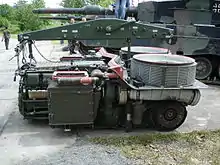

The Leopard 2 is propelled by the MTU MB 873 Ka-501 engine, which provides 1,500 PS (1.1 MW) at 2600 RPM and 4,700 N⋅m (3,500 lb⋅ft) of torque at 1600-1700 RPM. The MTU MB 873 Ka-501 is a four-stroke, 47.7 litre, 90° V-block 12-cylinder, twin-turbocharged and intercooled, liquid-cooled diesel engine (with multi-fuel capability), which has an estimated fuel consumption rate of around 300 litres per 100 km on roads and 500 litres per 100 km across country, and is coupled to the Renk HSWL 354 gear and brake system.[95][113] The Renk HSWL 354 transmission has four forward and two reverse gears, with a torque converter and is completely automatic, with the driver selecting the range.[95] The Leopard 2 has four fuel tanks, which have a total capacity of approximately 1160 litres, giving a maximum road range of about 500 km.[95] The propulsion pack is capable of driving the tank to a top road speed of 68 km/h (limited to 50 km/h during peacetime by law), and top reverse is 31 km/h.[114] The power pack can be changed in the field in 35 minutes.[95] The engine and transmission is separated from the crew compartment through a fireproof bulkhead.[113] An enhanced version of the EuroPowerPack, with a 1,650 PS (1.2 MW) MTU MT883 engine has also been trialled by the Leopard 2.[113]
The Leopard 2 has a torsion bar suspension and has advanced friction dampers. The running gear consists of seven dual rubber-tyred road wheels and four return rollers per side, with the idler wheel at the front and drive sprocket at the rear.[95] The tracks are Diehl 570F tracks, with rubber-bushed end connectors, which have removable rubber pads and use 82 links on each track. For use in icy ground, up to 18 rubber pads can be replaced by the same number of grousers, which are stored in the vehicle's bow when not in use.[95] The upper part of the tracks are covered with side skirts.[111]
The Leopard 2 can drive through water 4 meters (13 ft) deep using a snorkel or 1.2 meters (3 ft 11 in) without any preparation. It can climb vertical obstacles over one metre high.
The German Army has prioritised mobility in its Leopard 2, which might be the fastest main battle tank in the world.[115]
Variants
Leopard 2
The baseline Leopard 2, sometimes informally called the "A0" to differentiate it from later versions, was the first series manufactured version. The vehicles were manufactured from October 1979 until March 1982, altogether 380 vehicles. 209 were built by Krauss Maffei and 171 by MaK. The basic equipment consisted of electrical-hydraulic stabiliser WNA-H22, a fire control computer, a laser rangefinder, a wind sensor, a general-purpose telescope EMES 15, a panorama periscope PERI R17, the gunner's primary sight FERO Z18, on the turret roof as well as a computer-controlled tank testing set RPP 1–8. 200 of the vehicles had a low-light enhancer (PZB 200) instead of thermal imaging. Two chassis served as driver training vehicles.
Leopard 2A1
Minor modifications and the installation of the gunner's thermal sight[1] were worked into the second batch of 450 vehicles Leopard 2, designated the A1. Krauss-Maffei built 248 (Chassis Nr. 10211 to 10458) and Mak built 202 (Chassis Nr. 20173 to 20347). Deliveries of the 2A1 models started in March 1982 and ended in November 1983. The two most notable changes were the modification of the ammunition racks to be identical to those in the M1A1 Abrams, and redesigned fuel filters that reduce refuelling time.
A third batch of 300 Leopard 2, 165 by Krauss-Maffei (Chassis Nr. 10459 to 10623) and 135 by MaK (Chassis Nr. 20375 to 20509.), was built between November 1983 and November 1984. This batch included more minor changes that were later retrofitted to the earlier 2A1s.
Leopard 2A2
This designation was given to upgraded vehicles of the first batch of Leopard 2s, brought up to the standard of the second and third batches. This modernisation gradually replaced the original PZB 200 sights in the first batch with thermal sights for the EMES 15 as they became available. Furthermore, the upgrade included the fitting of filler openings and caps to the forward hull fuel tanks to allow separate refuelling, as well as the addition of a deflector plate for the periscope and a large coverplate to protect the existing NBC protection system. Finally, the tank was given new five metre towing cables with a different position. The programme began in 1984 and ended in 1987; the third, fourth and fifth batches, which were produced during this period, had the same features. The modernised first batch can be recognised by the circular plate covering the hole where the cross-wind sensor for the fire-control system was removed.[116]
Leopard 2A3
The fourth batch of 300 vehicles, 165 by Krauss-Maffei (Chassis Nr. 10624 to 10788) and 135 by Mak (Chassis Nr. 20510 to 20644), was delivered between December 1984 and December 1985. The main change was the addition of the SEM80/90 digital radio sets (also being fitted to the Leopard 1 at the same time), and the ammunition reloading hatches being welded shut. Even with these minor changes the new batch was known as the 2A3.
Leopard 2A4
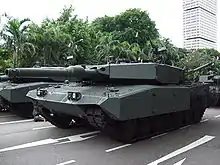
The most widespread version of the Leopard 2 family, the 2A4 models included more substantial changes, including an automated fire and explosion suppression system, an all-digital fire control system able to handle new ammunition types, and an improved turret with flat titanium/tungsten armour. The Leopard 2s were manufactured in eight batches between 1985 and 1992. All the older models were upgraded to 2A4 standard. Until 1994, Germany operated a total of 2,125 2A4s (695 newly built and the rest modified older versions), while the Netherlands had an additional 445 tanks. The 2A4 was also license manufactured in Switzerland as the Panzer 87 "Leopard" or Pz 87. This version included Swiss-built 7.5 mm MG 87 machine guns and communications equipment, and featured improved NBC protection system. Switzerland operated 380 Pz 87 tanks.
After 2000, Germany and the Netherlands found themselves with large stocks of tanks that they had no need for after the Cold War. These tanks were sold to NATO or friendly armies around the world. Among these buyers of the surplus tanks were Turkey (purchasing 354 vehicles), Greece (183), Sweden (160), Chile (140), Finland (139), Poland (128), Austria (114), Spain (108), Canada (107), Singapore (96), Norway (52), Denmark (51), and Portugal (37).[117]

The Pz 87WE (WertErhaltung) is a planned Swiss modification and upgrade of the Pz 87.[118] The modification significantly improves protection through the addition of the Leopard 2A6M's mine protection kit, thicker armour on the front glacis, and a turret equipped with a Swiss-developed armour package using titanium alloy. The turret roof armour is improved and the smoke grenade launchers redesigned. Further improvements enhance survivability and combat capability, such as a turret electric drive similar to the Leopard 2A5, a driver rear-view camera, an independent weapons station for the loader, and enhanced command and control systems. The fire control system is also upgraded, using the Carl Zeiss Optronics GmbH PERI-R17A2 fire control system. A remote weapons station containing a fully stabilised Mg 64 0.50 in (12.7 mm) machine gun is also fitted to the tank.
The Pz 87-140[119] is an experimental variant of the Swiss Pz 87 with a 140 mm gun and additional armour, which was later used on the newer production variants.
The Leopard 2A4CHL is the upgraded Chilean version of the Leopard 2A4 ordered by Chile in 2007. Upgrades include new electronics, sighting and information systems meant to elevate the Leopard 2A4's networking capability to be equal to that of the Leopard 2A6, a new suspension system and the upgrading of the tanks main gun to the L/55 smoothbore cannon used on the Leopard 2A6. Other upgrades are remote weapon stations over the gunner and commander hatches fitted with the MG3 and HK GMG. The Leopard 2A4CHL also has improved roof and side turret armour and can be uplinked with Chile's battlefield control network.
.jpg.webp)
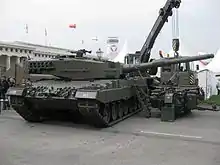
The Leopard 2A4M CAN is the upgraded Canadian version of the Leopard 2A4 acquired from the Royal Netherlands Army surplus. The Leopard 2A4M CAN is specially designed for the war in Afghanistan, based on experience gained by Leopard 2 operators. The first 20 were delivered in October 2010; of which just five were deployed to Afghanistan at the end of 2010 and operated until July 2011, when combat operations stopped.[120] Though originally planned to be up-gunned to the L/55 for consistency with the 2A6M CAN, the longer barrelled guns (optimised for tank-vs-tank warfare) were found to be less than ideal in Afghanistan, therefore it was decided to retain the L/44. In addition, only small areas of slat armour were added, in contrast with the fully caged 2A6M CANs. The protection of the Leopard 2A4M CAN has been further augmented by the addition of applique armour resembling that found on the most recent Leopard 2A7+ variant, but modified to fit the turret configuration of the 2A4.[121] Of the 2A4s acquired, 11 were converted for training use (9 A4s, 2 A4Ms). In February 2011, Canada bought 12 2A4s/Pz 87 from Switzerland for the 'Force Mobility Enhancement' project which, along with the remaining unused ex-Dutch tanks, saw 18 converted to Armoured Engineering Vehicles and 4 converted to Armoured Recovery Vehicles.[122] Canada has also purchased 15 2A4s from Germany as Logistic Stock Vehicles (for spare parts).
The Leopard 2NG (Next Generation) is a privately funded Turkish upgrade by ASELSAN that includes the application of modular composite armour (AMAP), upgraded optics, completely overhauled turret mechanics and a new fire control system on the work since 1995 and to be delivered by late 2011, which is intended to be used on the new Altay MBT. It was developed without an order of the Turkish Army, but might meet the requirements for the modernization of the Turkish Leopard 2A4s.[123] The old powerpack and the L/44 gun barrel are kept, but the combat weight is increased to 65 tonnes.[123] According to Turkish news sources, Finland was interested in getting the Turkish upgrade package to modernise their fleet of Leopard 2A4s. However, in 2015 Finland purchased 120 2A6 vehicles from the Netherlands.[124][125]
The Leopard 2 hull was also used for the Vickers Mk 7 main battle tank, which featured a British-designed turret, where some of the innovations later were incorporated into the Challenger 2 design.
In December 2015, Bumar-Łabędy signed an agreement with German Rheinmetall Landsysteme Gmbh concerning the technological support of the Polish modernization program for Leopard 2A4 tanks. The company will design, document and execute six prototypes. The first upgraded Leopard 2PL's have arrived in Poland in June 2020, with all 142 tanks to be delivered by 2023.[126] The upgrades include third generation night vision systems (production of the Warsaw PCO), new additional armor modules and anti-splash lining, removal of flammable components (turret drive system and main propulsion system), installation of new fire protection system, modernization of the tank's integrated monitoring and testing equipment, Possibility of using new types of ammunition (programmable DM-11 and DM-63), auxiliary generator set (APU). Construction of all 142 units will be completed by the end of 2020.
Turkey will modernize its Leopard 2 AMTs as Leopard 2A4TR. According to the Defense Industry Presidency, Leopard 2A4 tanks, with the said modernization; Reactive Reactive Armor (ERA), High Ballistic Strength Cage Armor, Hollow Modular Add-on Armor, Close Range Surveillance System (YAMGÖZ), Laser Warning Receiver System (LIAS), SARP Remote Command Weapon System (UKSS), PULAT Active Protection System (AKS), Power Distribution Unit, ASELSAN Driver Vision System (ADİS) and Voice Alert System integrations will be realized. The modernization will include 84 Leopard 2A4 tanks, including prototypes in the first place. However, in the coming periods, all Leopard 2A4 tanks - about 350 units - will be modernized.[127][128][129]
Leopard 2 Marksman
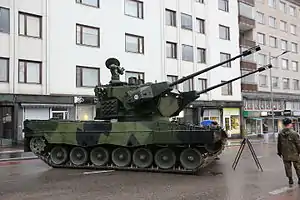
Finland has modernised its Marksman SPAAG vehicles by replacing the original T-55AM chassis with a newer Leopard 2A4 chassis.[130] The upgraded Marksman vehicles were scheduled to enter service with the Finnish Army in 2016.[131] The new Leopard 2 chassis greatly improves mobility compared to the older T-55AM chassis, both on- and off-road. The Leopard 2 chassis is also larger, thus providing a more stable firing platform for the Marksman turret to operate from.[132]
Leopard 2 Imp
"Leopard 2 Improved" was a prototype-series for enhancing the A4, introducing a wedge-shaped, spaced add-on armour to the turret front and the frontal area of the sides. These spaced armour modules defeat a hollow charge prior to reaching the base armour, and causes kinetic-energy penetrators to change direction, eroding them in the process; it does not form a shot-trap, since it does not deflect the penetrators outwards to hit the hull or turret ring. The gun mantlet was redesigned to accept the new armour.[96]
Leopard 2A5
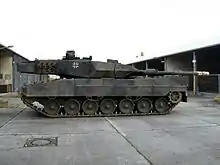
.jpg.webp)
From the Leopard 2 Imp was then developed into the A5. There were also some improvements in the main armour composition. The interior received spall liners to reduce fragments if the armour is penetrated. The frontal "heavy" third of the side skirts was replaced with a stronger type. The commander's sight was moved to a new position behind the hatch and it received an independent thermal channel. The gunner's sight was moved to the turret roof as opposed to the cavity in the front armour in previous models. A heavier sliding driver's hatch was fitted. Turret controls went all-electric, increasing reliability and crew safety, as well as weight savings. The gun braking system was improved to prepare for the later mounting of the new L/55 gun tube and to enable firing of more powerful ammunition, such as the DM-53 APFSDS. The first A5s were handed over to the German army tank school in 1995 and started to enter regular service with Panzerbataillon 33 in December the same year.[133]
The Leopard 2A5 DK is a variant of the Leopard 2A5 similar to the Leopard 2A6 with some small modifications, used by the Danish Army.[134]
Stridsvagn 122
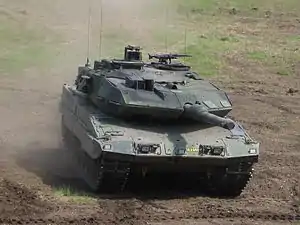
Also based on the Leopard 2 Improved, Stridsvagn 122 is a Swedish Army tank with 120 units built, 91 of which were licence-produced in Sweden. The tank features increased armour on the turret top and front hull, and improved command-, control- and fire-control systems. Externally, it can be distinguished from the Leopard 2A5 by the French GALIX smoke dispensers, different storage bins, and the much thicker crew hatches.[96] The Strv 122B, a variant equipped with modular AMAP composite armour from IBD Deisenroth, has increased 360° protection against threats like EFPs, RPGs and IEDs.[135] The width of 4 metres (13 ft) has been kept, while the weight increases by only 350 kilograms (770 lb).[135]
Leopard 2-140
In the early 1990s, Rheinmetall began development of a 140 mm smoothbore cannon for use in future tank designs. The new gun was intended to counter new Soviet tank developments, especially since the next generation of Soviet main battle tanks were rumoured to be armed with a 135 mm or 152 mm cannon. The new 140 mm cannon was part of a modernisation programme for the Leopard 2 known as the KWS III.[136][137] Test firing of the new 140 mm cannon was conducted. Results showed that the gun had high penetration values, and had a muzzle velocity of around 2000 metres a second, with potential to be increased further. However, the 140 mm rounds were too heavy for the tank crew to handle effectively.[137]
The KWS III upgrade was to feature a new turret. This new turret was equipped with the planned 140 mm cannon and an autoloader. The introduction of an autoloader reduced the tank's crew to three members, as a dedicated loader was no longer needed. The gun's 32 rounds of ammunition were stored separate from the crew in a large compartment occupying the entire rear of the turret, in order to increase crew survivability in the event of a cook off. The turntable-style turret had the gun offset to the left side, due to the autoloader's lateral feeding of ammunition into the cannon breech. The turret was powered by an electro-hydraulic drive and also featured an IFIS battlefield management system. The crew was protected by an armoured capsule and ballistic protection for the hull was to be improved; planned protection level of the KWS III upgrade was to be equal to or better than the Leopard 2A5.[33][136][137]
A total of 650 Leopard 2 KWS III tanks were originally projected to be purchased.[34] However, in 1995, the KWS III programme was cancelled due to changes in the political environment.
Despite this, development still continued on the 140 mm cannon, with Rheinmetall coordinating with the British Royal Ordnance and French GIAT companies.[137] The 140 mm cannon was fitted to an old Leopard 2 prototype with the turret T19.[138] Counterweights were added to the rear of the turret to balance the increased weight of the 140 mm cannon; however, the modified Leopard 2 was not equipped with any other KWS III upgrades apart from the new gun. Live fire testing showed mixed results, where the 140 mm cannon showed superior penetrating power compared to the existing 120 mm cannon, but also demonstrated poorer handling characteristics.[136][137] The lack of the autoloader on the prototype further hampered performance.[136]
Leopard 2A6
The Leopard 2A6 includes the addition of the Rheinmetall 120 mm L/55 smoothbore gun and other changes. All German tank battalions of the "crisis intervention forces" are equipped with the A6. Canada purchased 20 Leopard 2A6s from the Netherlands. These were delivered in 2007.[139] Portugal also purchased 37 Leopard 2A6 from the Dutch in 2007, with delivery in 2008. In January 2014, Finland purchased 100 L2A6s, as well as munitions, simulators, and a ten-year supply of reserve parts from the Netherlands. The tanks were delivered in batches between 2015-2019.[140]
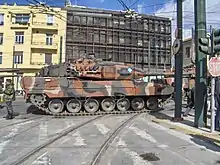
The Leopard 2A6M is a version of the 2A6 with enhanced mine protection under the chassis, and internal enhancements to improve crew survivability.[141] In the summer of 2007, Canada borrowed 20 A6Ms from Germany for deployment to Afghanistan. The Leopard 2 Hel is a derivative of the 2A6 that was ordered by the Greek Army in 2003 - the "Hel" stands for "Hellenic". The 170 tanks were to be delivered between 2006 and 2009. A total of 140 will be built in Greece by ELBO, which delivered the first units in late 2006.[142]
The Leopard 2A6M CAN is a Canadian variant of the Leopard 2A6M. Significant modifications include distinctive black boxes mounted on the rear of the turret bustle,[143] and stand-off slat armour.[144] The first tanks configured in this variant were 20 loaned from the German Bundeswehr in an effort to increase firepower and protection given to Canadian troops operating in the south of Afghanistan. The loaned tanks retain their German MG3 machine guns, the ex-Dutch tanks are also expected to retain their FN MAG machine guns due to commonality with Canadian stocks of C6 GPMG, itself a variant of the FN MAG.[145] Due to the loaned status of the first 20 tanks, the air conditioning unit originally could not be installed as only minimal changes could be made (the crew wore cooling vests instead, and the turret's electric drive generates less heat than the hydraulic drive of the older Leopard C2). The loaned German tanks will be kept by the Canadian Forces and may be further upgraded, while ex-Dutch Leopard 2A6s were modified to German Leopard 2A6M specifications and used as restitution for the loaned tanks.[146] Canadian Leopard 2s in Afghanistan were later fitted with air conditioning units (a much needed commodity in the scorching desert of Afghanistan) and Saab's Barracuda camouflage mats, which also serve to reduce solar loading by 50 percent.[104]
The Leopard 2A6TR was the Turkish variant during Turkish Army's tank procurement project in the year 2000. The version was based on 2A6EX. The project was dropped in favor of developing indigenous Altay tank.[147]
Leopard 2E
The Leopard 2E is a derivative of the 2A6, with greater armour protection,[148] developed under a programme of co-production between the defence industries of Spain and Germany. The programme was developed within the frame of collaboration decided in 1995 between the Defence Ministries of both countries, in which also was included the cession of use by a period of five years of 108 Leopard 2A4 from the German Army to the Spanish Army. However, this cession was extended up to 2016, and after that those tanks will be the sole property of the Spanish Army, as has been made public on 24 January 2006, then having been paid a total of 15,124,014 euros in ten yearly installments, giving the Spanish co-ownership from 2006. In 1998, the Spanish government agreed to contract 219 tanks of the Leopard 2E line, 16 recovery tanks Leopard 2ER (Bufalo) and 4 training vehicles. They chose Santa Bárbara Sistemas as the main contractor. The programme, with a budget of 1,939.4 million Euros, also includes the integrated logistical support, training courses for crew instructors and maintenance engineers and driving, turret, maintenance, aiming and shooting simulators. Deliveries of the first batch began in 2004.
Leopard 2PL
The Leopard 2PL is a Polish modernized version of the Leopard 2 A4 tanks, carried out in cooperation with Rheinmetall and the Polish Armaments Group (pol. Polska Grupa Zbrojeniowa PGZ). The MBT Leopard 2PL is mainly tasked to assault and maintain terrain, supporting mechanized and motorized subdivisions is realized with its on-board weapon systems in all weather conditions both during the day and night. Tanks already serviced in Polish Land Forces. Mainly compared to the Leopard 2A4, upgrade indudes following issues is: modernization of the commander's and gunner's sight, additional ballistic modules on the turret, replacement of the hydraulic stabilization system to new electric system, installation of modernized Fire Extinguishing and new Fire Suppression systems, implementation of a new commander's control and monitoring system, implementation of Auxiliary Power Unit- APU, newturret stowage compartment for crew equipment and customized towing-evacuation equipment to the increased weight of the tank, modernization of main gun with its adaptation to the new types of ammunition, implementation of the day-night drivers rear camera.[149][150]
Leopard 2 PSO

The new Leopard 2 PSO (Peace Support Operations) variant is designed specially for urban warfare, which had been encountered in peacekeeping operations with increasing frequency. Therefore, the Leopard 2 PSO is equipped with more effective all-around protection, a secondary weapons station, improved reconnaissance ability, a bulldozer blade, a shorter gun barrel (for manoeuvring on urban streets at the expense of fire range), non-lethal armament, close-range surveillance ability (through camera systems), a searchlight and further changes to improve its perseverance and mobility in a built-up non-wide open area. These features are similar to the Tank Urban Survival Kit for the American M1A2 Abrams.
Leopard 2A7
The Leopard 2A7 is fundamentally different from the KMW variant 2A7+ and is not optimised for combat in urban terrain. A total of 20 vehicles are provided for converting. It involves former Dutch A6NL models returned by Canada to Germany. The original upgrade to A6M has been extended in coordination with Canada and includes a crew-compartment cooling-system from the Leopard 2 A6M-HEL series, a new 20 kW auxiliary power unit based on the Steyr Motors M12 TCA UI engine,[151] the Saab Barracuda Mobile Camouflage System (MCS) with Heat-Transfer Reduction (HTR CoolCam) system,[152] a field trial proven combat management and information system (IFIS: Integriertes Führungs- und Informationssystem), onboard network optimization with ultracapacitors in the chassis and turret, a SOTAS IP digital intercom system, a renewal of the fire suppression system in the crew compartment, and the retrofitting of Attica thermal imaging module in the commander optics. The weapon system is adapted for firing HE ammunition. It is also fitted for, but not with, additional passive side protection armour. The first Leopard 2A7 was handed over to the German Army in Munich on 10 December 2014. A total of 14 vehicles were produced for Tank Battalion 203, plus four more going to the Armoured Corps Training Centre and one vehicle at the Technical School for Land Systems and School for Technology of the Army. The last tank remains as a reference vehicle at KMW.[37]
The Danish Armed Forces received its first Leopard 2A7 main battle tanks upgraded in Germany from the Leopard 2A5DK version at the Dragoon Barracks in Holstebro. The Danish Army will receive a total of 44 Leopard 2A7 vehicles by 2022.[153]
Leopard 2A7+
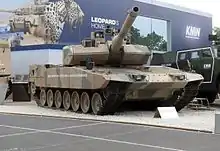
The Leopard 2A7+ was first shown to the public during the Eurosatory 2010, featuring the label "Developed by KMW – tested and qualified by the German Ministry of Defence". The Leopard 2A7+ has been tested by the Bundeswehr under the name UrbOp (urban operations).
The Leopard 2A7+ is designed to operate both in low intensity and high intensity conflicts.[154] The tank's protection has been increased by modular armour; the frontal protection has been improved with a dual-kit on the turret and hull front, while 360° protection against RPGs and mine protection increase the survivability of the tank in urban operations.[154] The modular armour's system components were first used by Canada in Afghanistan.[155] It can fire programmable HE munitions and the turret mounted MG3 has been replaced with a stabilised FLW 200 remotely controlled weapon station. The mobility, sustainability and situational awareness have also been improved.[154]
In December 2018, Hungary ordered 44 2A7+s, making them the second operator of the improved version, after Qatar.[61][62]
Engineering and driver training tanks
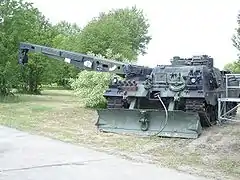
- Bergepanzer BPz3 Büffel (Gr. Buffalo)
- The BPz3 armoured recovery vehicle includes both a bulldozer and a crane with integral winch, allowing it to approach damaged vehicles, even over rough and fought-over terrain, and tow them to safety. It is equipped with a machine gun for local self-defence, a smoke grenade launcher, and NBC protection. Like the tank, it is powered by a 1,500 PS (1,479 hp, 1,103 kW) diesel engine. In service with Germany (where it is also designated Büffel or Bergepanzer 3 for Salvage Tank 3), the Netherlands (who co-developed it and call it Buffel), Austria, Canada, Greece, Singapore (where it is called L2-ARV locally), Spain (where it is called Leopard 2ER Búfalo), Sweden (in modified form as the Bgbv 120), and Switzerland (BPz3).
- Panzerschnellbrücke 2
- This vehicle, created by MAN Mobile Bridges GmbH, is an armoured vehicle-launched bridge developed from the Leopard 2 tank chassis. It is designed to carry a folding mobile bridge, which it can "launch" across a river. Once emplaced, the bridge is sturdy enough to support most vehicles, even other Leopard tanks. When the crossing is complete, the bridge-layer simply hooks up to the bridge and re-stows it.

- Panzerschnellbrücke Leguan
- This modular system combines a bridge module created by MAN Mobile Bridges GmbH with a tank chassis. The Bundeswehr is testing the Leguan on Leopard 2 chassis.[156]
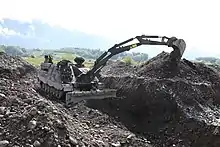
- AEV 3 Kodiak
- A combat engineering vehicle conversion of the Leopard 2, the Kodiak is used by the armed forces of the Dutch army, Singapore, Sweden and Switzerland. While equipped with a bulldozer, excavator, and dual capstan winches, the AEV 3 Kodiak has no turret instead, a Remote Weapon Station or other armament can be fitted. It is built on the Leopard 2 chassis with a built-up forward superstructure. The vehicle is used primarily for the clearance of obstacles (including minefields). The Dutch version has additional bomblet protection for the crew compartments. Spain may procure 24 examples for the Spanish Army from converted Leopard 2A4 hulls (one vehicle has been trialled in Spain)[157] and the type will be offered to Germany.
- Driver Training Tank (Fahrschulpanzer)
- The Leopard 2 Driver Training Tank, as the name implies, is a non-combatant Leopard 2 for instructing soldiers in the finer points of handling the tank. The turret is supplanted by a weighted and fixed observation cab with forward and side-facing windows and a dummy gun. The instructor rides in this cab, with override controls for critical systems, and space is provided for two other students to observe.
- Leopard 2R
- Heavy mine breaching vehicle developed by Patria for the Finnish Army, based on the Leopard 2A4. Ten vehicles were converted. The vehicles are equipped with a mine-plough or a dozer blade, and an automated marking system.[158][159]
- Leopard 2L
- Armoured vehicle-launched bridge developed by KMW and Patria for the Finnish Army. Ten Finnish 2A4 tanks were re-built to carry the LEGUAN bridge.[158][159]
- WISENT 2
- Multi-purpose, Leopard 2–based Armoured Support Vehicle developed by Flensburger Fahrzeugbau. The vehicle's modular design allows it to be converted quickly from an Armoured Recovery Vehicle (ARV) to an Armoured Engineer Vehicle (AEV) in less than five hours.[160]
Technical data
| Description | Leopard 2A4 | Leopard 2A5 | Leopard 2A6/A6M | ||||||
|---|---|---|---|---|---|---|---|---|---|
| Crew: | 4 | ||||||||
| Engine: | MTU MB 873 Ka-501 12-cylinder twin-turbocharged diesel engine | ||||||||
| Displacement: | Bore × stroke: 170 × 175 mm, 47,666 cm3 displacement | ||||||||
| Power output: | 1,500 PS (1,479 hp, 1,103 kW), rpm: 2,600/min | ||||||||
| Torque output: | 4,700 Nm (3,466 lb·ft), rpm: 1,600–1,700/min | ||||||||
| Transmission: | Hydro-mechanical control, reversing and steering gear HSWL 354 with combined hydrodynamic-mechanical service brake, 4 forward, 2 reverse | ||||||||
| Suspension system: | Torsion bar spring mounted support roller drive with hydraulic dampers | ||||||||
| Length Turret forward: | 9.67 m | 10.97 m | |||||||
| Width: | 3.7 m | 3.76 m | |||||||
| Height: | 2.79 m | 3.03 m | |||||||
| Ground clearance: | 0.54 m | ||||||||
| Wading depth without preparation: | 1.2 m | ||||||||
| Wading depth with snorkel: | 4 m | ||||||||
| Trench passability: | 3 m | ||||||||
| Climbing ability: | 1.1 m | ||||||||
| Empty weight: | 52 t | 57.3 t | 57.6 t A6M 60.2 t | ||||||
| Combat weight: | 55.15 t | 59.5 t | A6 59.9 t (maximum mass; 61.7 t), A6M 62.5 t | ||||||
| Maximum speed: | 68 km/h; backwards 31 km/h | ||||||||
| Fuel capacity: | 1,160 liters (limited to 900 liters when not in battle) | ||||||||
| Fuel consumption and operating range: |
Road: ca. 340 l/100 km, ca. 340 km | ||||||||
| Rotation time (360°): | 10 seconds | ||||||||
| Armament: | Rheinmetall 120 mm smoothbore gun L/44 and 2 machine guns | Rheinmetall 120 mm smoothbore gun L/55 and 2 machine guns | |||||||
| Turret weight: | 16 t | 21 t | |||||||
| Turret rotation time: | 360° in 9 seconds (electric) | ||||||||
Operators
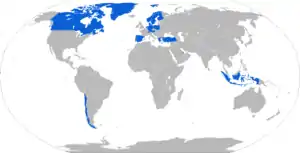
Current operators
 Austria: The Austrian Army acquired 114 Leopard 2A4s from surplus Dutch stocks plus one turret.
Austria: The Austrian Army acquired 114 Leopard 2A4s from surplus Dutch stocks plus one turret..svg.png.webp) Canada: The Canadian Army acquired 80 Leopard 2A4 and 20 Leopard 2A6 tanks from the Netherlands in 2007. Twenty Leopard 2A6M were borrowed from the German Army beginning in mid-2007 to support the Canadian deployment in Afghanistan,[139] with the first tank handed over after upgrading by KMW on 2 August 2007,[141][162] and arriving in Afghanistan on 16 August 2007.[143] Two Bergepanzer 3 Büffel were purchased from the German Army for use with the Canadian deployment in Afghanistan.[163] An additional fifteen Leopard 2A4 tanks were purchased from the German Army as Logistic Supply Vehicles (for spare parts).[164] A further 12 surplus Pz 87 were purchased from Switzerland in 2011 for conversion to armoured recovery vehicles.[165] A final total of 112 tanks of all variants is to be fielded by the Canadian Army: 82 gun tanks (42 2A4+, 20 2A4M CAN and 20 2A6M CAN - all delivered as of March 2016), 12 ARVs (11 of 12 delivered as of March 2016) and 18 AEVs (conversion of which is ongoing).[166]
Canada: The Canadian Army acquired 80 Leopard 2A4 and 20 Leopard 2A6 tanks from the Netherlands in 2007. Twenty Leopard 2A6M were borrowed from the German Army beginning in mid-2007 to support the Canadian deployment in Afghanistan,[139] with the first tank handed over after upgrading by KMW on 2 August 2007,[141][162] and arriving in Afghanistan on 16 August 2007.[143] Two Bergepanzer 3 Büffel were purchased from the German Army for use with the Canadian deployment in Afghanistan.[163] An additional fifteen Leopard 2A4 tanks were purchased from the German Army as Logistic Supply Vehicles (for spare parts).[164] A further 12 surplus Pz 87 were purchased from Switzerland in 2011 for conversion to armoured recovery vehicles.[165] A final total of 112 tanks of all variants is to be fielded by the Canadian Army: 82 gun tanks (42 2A4+, 20 2A4M CAN and 20 2A6M CAN - all delivered as of March 2016), 12 ARVs (11 of 12 delivered as of March 2016) and 18 AEVs (conversion of which is ongoing).[166] Chile: The Chilean Army acquired 132 Leopard 2A4s upgraded to the Leopard 2A4CHL standard (plus 8 to be used as spares) from German stocks in 2007.[167][168] In April 2013, Chile began negotiations to purchase 100 Leopard 2A5 tanks from surplus German stocks, as well as modernization kits to upgrade all its current Leopard 2A4s up to A5 standard.[169]
Chile: The Chilean Army acquired 132 Leopard 2A4s upgraded to the Leopard 2A4CHL standard (plus 8 to be used as spares) from German stocks in 2007.[167][168] In April 2013, Chile began negotiations to purchase 100 Leopard 2A5 tanks from surplus German stocks, as well as modernization kits to upgrade all its current Leopard 2A4s up to A5 standard.[169] Denmark: The Royal Danish Army operates 57 Leopard 2A5DK (equal to Leopard 2A6 minus the L/55 gun).[170] 44 tanks are to be upgraded to A7 standard, with Danish modifications, between 2019-22.[171]
Denmark: The Royal Danish Army operates 57 Leopard 2A5DK (equal to Leopard 2A6 minus the L/55 gun).[170] 44 tanks are to be upgraded to A7 standard, with Danish modifications, between 2019-22.[171] Finland: The Finnish Army originally bought 124 2A4s from surplus German stocks in 2003.[172] Of these, 12 were converted into bridge-laying and combat engineering tanks and 12 were disassembled for use as spares, leaving 100 operational tanks.[173][174] In 2009, the Finnish Army bought 15 more German surplus Leopard 2A4s for spare parts of existing fleet, bringing the total number of Finnish Leopard 2A4 tanks to 139.[175] On 16 January 2014, Finland agreed with the Netherlands to purchase 100 used Leopard 2A6NL tanks for approximately €200 million.[176] In 2015, most of the Leopard 2A4s were moved into reserve, with some converted into Marksman AA vehicles, bridge-laying and mine clearing tanks.[177]
Finland: The Finnish Army originally bought 124 2A4s from surplus German stocks in 2003.[172] Of these, 12 were converted into bridge-laying and combat engineering tanks and 12 were disassembled for use as spares, leaving 100 operational tanks.[173][174] In 2009, the Finnish Army bought 15 more German surplus Leopard 2A4s for spare parts of existing fleet, bringing the total number of Finnish Leopard 2A4 tanks to 139.[175] On 16 January 2014, Finland agreed with the Netherlands to purchase 100 used Leopard 2A6NL tanks for approximately €200 million.[176] In 2015, most of the Leopard 2A4s were moved into reserve, with some converted into Marksman AA vehicles, bridge-laying and mine clearing tanks.[177] Germany: The German Army had approximately 250 Leopard 2 tanks in service as of March 2015.[178] This number will be increased to 328 A6, A6M and A7 tanks.[179]
Germany: The German Army had approximately 250 Leopard 2 tanks in service as of March 2015.[178] This number will be increased to 328 A6, A6M and A7 tanks.[179] Greece: The Hellenic Army operates 183 Leopard 2A4s and 170 Leopard 2A6 HEL vehicles.
Greece: The Hellenic Army operates 183 Leopard 2A4s and 170 Leopard 2A6 HEL vehicles. Hungary: A deal for 44 Leopard 2A7+ and 12 second hand Leopard 2A4 was signed on 19 December 2018.[61][62] All twelve A4s arrived as of 1 December 2020.[180]
Hungary: A deal for 44 Leopard 2A7+ and 12 second hand Leopard 2A4 was signed on 19 December 2018.[61][62] All twelve A4s arrived as of 1 December 2020.[180] Indonesia: Indonesia sought and obtained approval for the purchase of 103 used Leopard 2A4 tanks from Bundeswehr stocks, along with 4 Büffel ARV (Bergepanzer), 3 Leguan AVLB bridge-laying tanks (Brückenlegepanzer) and 3 Kodiak AEV (Pionierpanzer). About 63 of Leopard 2A4 will be upgraded to Revolution standard by Rheinmetall. 50 Marder 1A3 infantry fighting vehicles would also be acquired as part of the deal.[181] In September 2013, the Indonesian Army (TNI-AD or Tentara Nasional Indonesia - Angkatan Darat) received the first two Leopard 2A4 tanks and 2 Marder 1A3 infantry fighting vehicles. The used Leopard 2s have been modified to suit Indonesia's tropical climate, and have been internally renamed as Leopard 2RI (RI for "Republic of Indonesia").[182]
Indonesia: Indonesia sought and obtained approval for the purchase of 103 used Leopard 2A4 tanks from Bundeswehr stocks, along with 4 Büffel ARV (Bergepanzer), 3 Leguan AVLB bridge-laying tanks (Brückenlegepanzer) and 3 Kodiak AEV (Pionierpanzer). About 63 of Leopard 2A4 will be upgraded to Revolution standard by Rheinmetall. 50 Marder 1A3 infantry fighting vehicles would also be acquired as part of the deal.[181] In September 2013, the Indonesian Army (TNI-AD or Tentara Nasional Indonesia - Angkatan Darat) received the first two Leopard 2A4 tanks and 2 Marder 1A3 infantry fighting vehicles. The used Leopard 2s have been modified to suit Indonesia's tropical climate, and have been internally renamed as Leopard 2RI (RI for "Republic of Indonesia").[182] Netherlands: The Royal Netherlands Army operated 445 Leopard 2s. 330 of these were updated to 2A5 standard in 1993, and later, 188 of these were converted to 2A6 standard. Many Leopard 2s were sold after the end of the Cold War. On 8 April 2011, the Dutch Ministry of Defence announced that the last remaining tank division would be disbanded and the remaining Leopard tanks sold due to large budget cuts.[183] On 18 May 2011, the last tank fired the final shot at the Bergen-Hohne Training Area. They were due to be delivered to the Indonesian Army, which planned to purchase the entire Dutch stock of Leopard 2A6s.[184] However, the deal was scrapped after opposition from the Dutch Parliament.[185] The Dutch Army offered its formerly operated Leopard 2A6s for comparative tests to be conducted by the Peruvian Army for possible acquisition.[186] By September 2013, the Leopard 2A6 had been disqualified by Peru due to logistical complexities.[187] The Leopard 2s were eventually sold to Finland in a deal signed in January 2014 for €200 million with deliveries to start from 2015 to 2019.[188] On 15 September 2015, the Dutch government published that the army would have 16 tanks put out of storage and 18 were to be leased from Germany for a new tank squadron by 2016 as part of a German armoured battalion. One Leopard 2 tank is exhibited at the military museum.[189]
Netherlands: The Royal Netherlands Army operated 445 Leopard 2s. 330 of these were updated to 2A5 standard in 1993, and later, 188 of these were converted to 2A6 standard. Many Leopard 2s were sold after the end of the Cold War. On 8 April 2011, the Dutch Ministry of Defence announced that the last remaining tank division would be disbanded and the remaining Leopard tanks sold due to large budget cuts.[183] On 18 May 2011, the last tank fired the final shot at the Bergen-Hohne Training Area. They were due to be delivered to the Indonesian Army, which planned to purchase the entire Dutch stock of Leopard 2A6s.[184] However, the deal was scrapped after opposition from the Dutch Parliament.[185] The Dutch Army offered its formerly operated Leopard 2A6s for comparative tests to be conducted by the Peruvian Army for possible acquisition.[186] By September 2013, the Leopard 2A6 had been disqualified by Peru due to logistical complexities.[187] The Leopard 2s were eventually sold to Finland in a deal signed in January 2014 for €200 million with deliveries to start from 2015 to 2019.[188] On 15 September 2015, the Dutch government published that the army would have 16 tanks put out of storage and 18 were to be leased from Germany for a new tank squadron by 2016 as part of a German armoured battalion. One Leopard 2 tank is exhibited at the military museum.[189] Norway: The Norwegian Army has 52 ex-Dutch Leopard 2A4NOs in stock. 36 of these were operational as of 2017.[190] In May 2015, it was announced that the Norwegian Army had ordered 6 Wisent 2 in the ARV configuration.[191] A second order of 6 Wisent 2 was announced in September 2018, but these will be delivered in the AEV configuration.[192] In March 2019, Norway signed an agreement with Krauss-Maffei Wegmann for the procurement of 6 new LEGUAN bridgelayers, with deliveries to begin in summer 2022.[193][194]
Norway: The Norwegian Army has 52 ex-Dutch Leopard 2A4NOs in stock. 36 of these were operational as of 2017.[190] In May 2015, it was announced that the Norwegian Army had ordered 6 Wisent 2 in the ARV configuration.[191] A second order of 6 Wisent 2 was announced in September 2018, but these will be delivered in the AEV configuration.[192] In March 2019, Norway signed an agreement with Krauss-Maffei Wegmann for the procurement of 6 new LEGUAN bridgelayers, with deliveries to begin in summer 2022.[193][194] Poland: The Polish Land Forces operate 142 Leopard 2A4s, 105 Leopard 2A5s and two Fahrschulpanzer Leopard 2 (turretless driver training vehicle) locally known as Leopard 2 NJ. All Polish Leopard 2 tanks come from German Army stocks. First batch of 128 Leopard 2A4s (produced between 1985 and 1987) as well as 49 other armoured vehicles (like Bergepanzer 2 ARVs and M113 family APCs) and 151 trucks and 4x4s was transferred to Poland in 2002 and 2003 for 100 million PLN and is used by 10th Armoured Cavalry Brigade based in Świętoszów. Second batch of 105 Leopard 2A5s and 14 Leopard 2A4s as well as 18 Bergepanzer 2 ARVs and 200 trucks and 4x4s was transferred to Poland in 2013 and 2014 for 780 million PLN. 128 Leopard 2A4 are scheduled to be upgraded to Leopard 2PL standard, contract worth 2,415M PLN was signed on 28 December 2015. In 2018 a follow-on deal to upgrade a second batch of 14 Leopard 2 A4s was signed.[195] Leopard 2PL will introduce new sighting equipment for gunner, commander and driver, increased protection level, upgraded gun, upgraded fire suppression system and installation of auxiliary power unit.[196][197][149]
Poland: The Polish Land Forces operate 142 Leopard 2A4s, 105 Leopard 2A5s and two Fahrschulpanzer Leopard 2 (turretless driver training vehicle) locally known as Leopard 2 NJ. All Polish Leopard 2 tanks come from German Army stocks. First batch of 128 Leopard 2A4s (produced between 1985 and 1987) as well as 49 other armoured vehicles (like Bergepanzer 2 ARVs and M113 family APCs) and 151 trucks and 4x4s was transferred to Poland in 2002 and 2003 for 100 million PLN and is used by 10th Armoured Cavalry Brigade based in Świętoszów. Second batch of 105 Leopard 2A5s and 14 Leopard 2A4s as well as 18 Bergepanzer 2 ARVs and 200 trucks and 4x4s was transferred to Poland in 2013 and 2014 for 780 million PLN. 128 Leopard 2A4 are scheduled to be upgraded to Leopard 2PL standard, contract worth 2,415M PLN was signed on 28 December 2015. In 2018 a follow-on deal to upgrade a second batch of 14 Leopard 2 A4s was signed.[195] Leopard 2PL will introduce new sighting equipment for gunner, commander and driver, increased protection level, upgraded gun, upgraded fire suppression system and installation of auxiliary power unit.[196][197][149] Portugal: The Portuguese Army has 37 ex-Dutch Leopard 2A6s in service. Also bought 1 for training and 1 for spares.[198]
Portugal: The Portuguese Army has 37 ex-Dutch Leopard 2A6s in service. Also bought 1 for training and 1 for spares.[198] Qatar: Qatar signed a contract for 62 Leopard 2A7+ tanks in April 2013.[199] Deliveries commenced in late 2014/early 2015[200] and will be completed in 2018.[201] The first units were displayed at Qatar's annual national day parade on 18 December 2015.[202]
Qatar: Qatar signed a contract for 62 Leopard 2A7+ tanks in April 2013.[199] Deliveries commenced in late 2014/early 2015[200] and will be completed in 2018.[201] The first units were displayed at Qatar's annual national day parade on 18 December 2015.[202] Singapore: The Singapore Army acquired 96 ex-German Leopard 2A4s, including 30 spare tanks. A number were upgraded with additional AMAP composite armour in 2010 by IBD Deisenroth and ST Kinetics and renamed Leopard 2SG in October 2010. By 2019, it was reported that Singapore had taken delivery of 170 Leopard 2A4s.[203][204]
Singapore: The Singapore Army acquired 96 ex-German Leopard 2A4s, including 30 spare tanks. A number were upgraded with additional AMAP composite armour in 2010 by IBD Deisenroth and ST Kinetics and renamed Leopard 2SG in October 2010. By 2019, it was reported that Singapore had taken delivery of 170 Leopard 2A4s.[203][204] Spain: The Spanish Army operates 327 Leopard 2s (108 ex-German Leopard 2A4s and 219 new-built Leopard 2A6+ (Leopard 2E). Spain offered its Leopard 2A4 for comparative tests to be conducted by the Peruvian Army for possible acquisition. By September 2013, the Leopard 2A4 had been disqualified by Peru due to logistical complexities.[187]
Spain: The Spanish Army operates 327 Leopard 2s (108 ex-German Leopard 2A4s and 219 new-built Leopard 2A6+ (Leopard 2E). Spain offered its Leopard 2A4 for comparative tests to be conducted by the Peruvian Army for possible acquisition. By September 2013, the Leopard 2A4 had been disqualified by Peru due to logistical complexities.[187] Sweden: In August 1994, 160 ex-German Leopard 2A4s were leased and received minor modifications; they were used under the designation Stridsvagn 121 until the reorganisation of the Swedish Army in 2000, when they were placed in storage until the lease contract expired in 2011. 20 Strv 121 tanks were purchased for conversion into engineer and bridge-laying vehicles, and the 140 remaining tanks were returned to Germany. Sweden has also acquired 120 Leopard 2 Improved tanks, upgrading them as the Stridsvagn 122, with 42 Strv 122 tanks remaining in active service.[205][206][207]
Sweden: In August 1994, 160 ex-German Leopard 2A4s were leased and received minor modifications; they were used under the designation Stridsvagn 121 until the reorganisation of the Swedish Army in 2000, when they were placed in storage until the lease contract expired in 2011. 20 Strv 121 tanks were purchased for conversion into engineer and bridge-laying vehicles, and the 140 remaining tanks were returned to Germany. Sweden has also acquired 120 Leopard 2 Improved tanks, upgrading them as the Stridsvagn 122, with 42 Strv 122 tanks remaining in active service.[205][206][207] Switzerland: The Swiss Army purchased 380 2A4s designated Pz 87 for Panzer 87. 35 of these were bought from Germany while the remaining ones were license manufactured locally. Beginning in 2006, 134 of these tanks have been modernised, 42 were sold back to Rheinmetall, and 12 were turned into de-mining and engineer vehicles. The remaining tanks are in storage.
Switzerland: The Swiss Army purchased 380 2A4s designated Pz 87 for Panzer 87. 35 of these were bought from Germany while the remaining ones were license manufactured locally. Beginning in 2006, 134 of these tanks have been modernised, 42 were sold back to Rheinmetall, and 12 were turned into de-mining and engineer vehicles. The remaining tanks are in storage. Turkey: The Turkish Army received 354 Leopard 2A4s.[117] 84 units are undergoing modernisation as Leopard 2A4TR
Turkey: The Turkish Army received 354 Leopard 2A4s.[117] 84 units are undergoing modernisation as Leopard 2A4TR
Future and potential operators
 Bulgaria: The Bulgarian Ministry of Defence has been interested in purchasing a minimum of 24 units of the Leopard 2A6 variant. The deal has received support from a military budget increase to 2.0% of GDP by 2016 in the new Bulgarian budget, and a military pledge to spend €2.2 billion on new armaments for the Bulgarian military.[208]
Bulgaria: The Bulgarian Ministry of Defence has been interested in purchasing a minimum of 24 units of the Leopard 2A6 variant. The deal has received support from a military budget increase to 2.0% of GDP by 2016 in the new Bulgarian budget, and a military pledge to spend €2.2 billion on new armaments for the Bulgarian military.[208] Czech Republic: In July 2016, officers of the Army of the Czech Republic visited a Spanish military base at Zaragoza where Spanish Leopards 2A4 are stored. The Czech Republic was interested in replacing their domestically-produced T-72M4CZ and aging T-72M/T-72M1. No official agreement was signed.[209] Later, the Czech Army unofficially announced that the Spanish Leopards were in a too poor condition to be purchased.[210]
Czech Republic: In July 2016, officers of the Army of the Czech Republic visited a Spanish military base at Zaragoza where Spanish Leopards 2A4 are stored. The Czech Republic was interested in replacing their domestically-produced T-72M4CZ and aging T-72M/T-72M1. No official agreement was signed.[209] Later, the Czech Army unofficially announced that the Spanish Leopards were in a too poor condition to be purchased.[210] Croatia: The Croatian Ministry of Defence is looking for replacemant of M-84A4 tanks currently in use. Negotiations with Germany over the purchase of stored Leopard 2A5 tanks were under way in 2014 and 2015. The Milanović Government was negotiating purchase of up to 50 tanks with spare parts and support package including spare engines, tank transporters and engineering vehicles valued at 875 million kuna. The purchase would have coincided with the purchase of PzH 2000 howitzers, but due to budget constrains, at least for the time being, the vehicles were not purchased. Interest still remains high however, as Croatia has no plans to modernise or maintain its M-84A4 tanks beyond 2020.[211]
Croatia: The Croatian Ministry of Defence is looking for replacemant of M-84A4 tanks currently in use. Negotiations with Germany over the purchase of stored Leopard 2A5 tanks were under way in 2014 and 2015. The Milanović Government was negotiating purchase of up to 50 tanks with spare parts and support package including spare engines, tank transporters and engineering vehicles valued at 875 million kuna. The purchase would have coincided with the purchase of PzH 2000 howitzers, but due to budget constrains, at least for the time being, the vehicles were not purchased. Interest still remains high however, as Croatia has no plans to modernise or maintain its M-84A4 tanks beyond 2020.[211]
Failed bids
 Saudi Arabia: The Saudi Arabian government is seeking to buy Leopard 2A7s (total of 600–800 desired). In early July 2011, the German press reported that the Bundessicherheitsrat (Federal Security Council) approved the sale by KMW of more than 200 units of the 2A7+ tanks to Saudi Arabia.[212][213] This news was met with criticism both inside and outside of Germany, because of the autocratic nature of the Saudi Arabian state and its involvement in repressing popular protests in the neighboring country of Bahrain.[214] Criticism also came from within the Chancellor Angela Merkel's government coalition,[215] and, later from within KMW.[216] In June 2012, reports surfaced that Saudi Arabia had raised the number of tanks it is interested in to 600–800. So far a contract has not been finalised, and the issue is debated both in the German public and in Germany's federal parliament.[217] On 13 April 2014, a German newspaper reported that the deal for Leopard 2 tanks for Saudi Arabia was likely to be cancelled due to opposition from the Federal Economy Minister at that time, Social Democrat Sigmar Gabriel.[218] In 2015, Germany blocked the sale of Leopards 2 to Saudi Arabia.[219]
Saudi Arabia: The Saudi Arabian government is seeking to buy Leopard 2A7s (total of 600–800 desired). In early July 2011, the German press reported that the Bundessicherheitsrat (Federal Security Council) approved the sale by KMW of more than 200 units of the 2A7+ tanks to Saudi Arabia.[212][213] This news was met with criticism both inside and outside of Germany, because of the autocratic nature of the Saudi Arabian state and its involvement in repressing popular protests in the neighboring country of Bahrain.[214] Criticism also came from within the Chancellor Angela Merkel's government coalition,[215] and, later from within KMW.[216] In June 2012, reports surfaced that Saudi Arabia had raised the number of tanks it is interested in to 600–800. So far a contract has not been finalised, and the issue is debated both in the German public and in Germany's federal parliament.[217] On 13 April 2014, a German newspaper reported that the deal for Leopard 2 tanks for Saudi Arabia was likely to be cancelled due to opposition from the Federal Economy Minister at that time, Social Democrat Sigmar Gabriel.[218] In 2015, Germany blocked the sale of Leopards 2 to Saudi Arabia.[219]
See also
Main Battle Tanks of comparable role, performance and era
- Challenger 2: British main battle tank
- Merkava IV: Israeli main battle tank
- Ariete: Italian main battle tank
- Leclerc: French main battle tank
- Type 99: Chinese main battle tank
- Type 96A: Chinese main battle tank
- Main Battle Tank 3000: Chinese main battle tank
- T-72: Soviet main battle tank
- T-80: Soviet main battle tank
- T-90: Post-Soviet Russian main battle tank
- T-84: Post-Soviet Ukrainian main battle tank
- M-95 Degman: Croatian main battle tank
- M-84AS: Serbian main battle tank
- Type 90 Kyū-maru: Japanese main battle tank
- Type 10: Japanese main battle tank
- M1 Abrams: US main battle tank
- K1 88-Tank: South Korean main battle tank
- K2 Black Panther: South Korean new main battle tank
- Merkava: Israeli main battle tank
- Zulfiqar (tank): Iranian Main Battle tank
- Al-Khalid: Pakistan main battle tank
- Altay: Future Turkish main battle tank
- Arjun MBT: Indian main battle tank
Notes
- In King of the Killing Zone Orr Kelly reported that after knocking on one Leopard 2AV prototype, a hollow sound was discovered by Colonel Robert J. Sunell. When confronting the German Colonel Kettman, he admitted that PT19 (the mobility test-bed) was not fitted with any special armour. Orr Kelly claims that the Leopard 2AV would have weighed 64 short tons instead of the 59.6 short tons and as a result the performance data of the mobility was invalidated. However, the weight value claimed by Orr Kelly does not match the actual weight of a Leopard 2 fitted with special armour nor does it match the weight mentioned in US documents from the evaluation.
References
- Gelbart, Marsh (1996). Tanks: main battle and light tanks. Brassey's UK Ltd. pp. 109–110. ISBN 978-1-85753-168-8. OCLC 36171829.
- "Canada Acquires 120 Leopard 2 Tanks from German, Dutch Surplus". Defense update. 16 April 2007. Archived from the original on 31 December 2009. Retrieved 12 October 2010.
- "Deutsche Panzer für Katar" (in German). Retrieved 26 October 2019.
- Foss, Christopher F (2002), Jane's Tanks and Combat Vehicles Recognition Guide, New York: HarperCollins, p. 32.
- Krapke, Paul-Werner (June 2004). Leopard 2 sein Werden und seine Leistung. Books On Demand. p. 81.
- Jerchel, p. 3
- Krapke, p. 19
- Krapke, p. 20
- Krapke, p. 22
- Jerchel, p. 5
- Hilmes, Rolf. "50 Jahre gepanzerte Kampftruppen". Panzertruppe. Archived from the original on 12 July 2018. Retrieved 22 February 2018.
- Jerchel, p. 6
- Hilmes, Rolf (1983). Kampfpanzer Entwicklungen der Nachkriegszeit (in German). Soldat Und Technik. p. 27. ISBN 9783524890012.
- Krapke, p. 27
- Jerchel, p. 7
- Krapke, p. 30
- Krapke, Paul-Werner (1984). Das Waffensystem Kampfpanzer Leopard 2 (in German). Allgemeine schweizerische Militärzeitschrift.
- Krapke, p. 32
- Jerchel, p. 8
- Krapke, p. 33
- Krapke, p. 34
- Krapke, p. 37 and 38
- Staats, Elmer B. (28 November 1977). Department Of Defense Consideration Of West Germany's Leopard As The Army's New Main Battle Tank. United States: U.S. Government Accountability Office.
- Krapke, p. 35
- "Orientalische Sitten". Der Spiegel. 14 March 1977. Archived from the original on 9 February 2016. Retrieved 16 December 2015.
- Krapke, p. 31
- Krapke, p. 41
- Krapke, p. 54 and 55
- Krapke, p. 38
- Jerchel, p. 10 and 11
- Krapke, p. 39
- Jerchel, p. 20 and 21
- Hilmes, Rolf (30 November 2007). Kampfpanzer heute und morgen: Konzepte - Systeme - Technologien (in German). Germany: Motorbuch Verlag. p. 68. ISBN 978-3613027930.
- Hilmes, Rolf (30 November 2007). Kampfpanzer heute und morgen: Konzepte - Systeme - Technologien (in German). Germany: Motorbuch Verlag. p. 70. ISBN 978-3613027930.
- Hilmes, Rolf (30 November 2007). Kampfpanzer heute und morgen: Konzepte - Systeme - Technologien (in German). Germany: Motorbuch Verlag. p. 69. ISBN 978-3613027930.
- Hilmes, Rolf (30 November 2007). Kampfpanzer heute und morgen: Konzepte - Systeme - Technologien (in German). Germany: Motorbuch Verlag. p. 71. ISBN 978-3613027930.
- "Germany receives first Leopard 2A7 MBT". IHS Jane's Defence Weekly. Archived from the original on 1 May 2015. Retrieved 22 December 2014.
- Alessa Weber; Patricia Franke (12 December 2014). "Neue "Leos" für das Heer". bundeswehr.de (in German). Bundeswehr. Archived from the original on 6 April 2016. Retrieved 29 March 2016.
- Jungholt, Thorsten (26 April 2015). "Bundeswehr-Kampfpanzer Leopard 2 fehlt wirksame Munition". DIE WELT. Retrieved 30 December 2020.
- Germany, France to jointly develop 'Leopard 3' tank Archived 25 May 2015 at the Wayback Machine - DeutscheWelle.de, 22 May 2015
- Get Ready, Russia: This European Power Has Plans For a Lethal New Tank Archived 7 June 2016 at the Wayback Machine - Nationalinterest.org, 18 February 2016
- Jerchel, p. 36
- Jerchel, p. 38
- Krauss-Maffei Wegmann Archived 1 March 2010 at the Wayback Machine
- Jerchel, p. 40
- "Greece, Krauss-Maffei Wegmann sign procurement contract for 170 Leopard 2 HEL MBTs". defense-aerospace.com. 20 March 2003. Archived from the original on 9 February 2016. Retrieved 11 January 2016.
- "Leopard 2 Main Battle Tank, Germany". Army-Technology.com. Archived from the original on 17 November 2015. Retrieved 11 January 2016.
- "Greece Signs Contracts for 183 Leopard 2s, 150 Leopard 1s". Defense Industry Daily. 5 August 2005. Archived from the original on 6 March 2016. Retrieved 11 January 2016.
- Jerchel, p. 42
- Ministerie van defensie - Nieuws Archived 8 May 2008 at the Wayback Machine
- "Germany to Sell 298 Leopard 2 Tanks to Turkey". defenseindustrydaily.com. 11 November 2005. Archived from the original on 22 January 2016. Retrieved 11 January 2016.
- "Asian Tiger Ordering Leopards". defenseindustrydaily.com. 12 December 2006. Archived from the original on 1 February 2016. Retrieved 18 January 2016.
- Hardy, James (12 November 2013). "Rheinmetall confirms Indonesian Leopard 2 contract". Jane's IHS. Archived from the original on 1 February 2016. Retrieved 11 January 2016.
- Foss, Christopher F. (16 June 2014). "Leopard migrates eastward". Jane's IHS. Archived from the original on 4 March 2016. Retrieved 11 January 2016.
- Foss, Christopher F. (21 February 2015). "Leopard ready to prowl in Qatar". Jane's IHS. Archived from the original on 19 December 2015. Retrieved 10 January 2016.
- Binnie, Jeremy (23 December 2015). "Qatar parades new equipment". Jane's IHS. Archived from the original on 7 January 2016. Retrieved 11 January 2016.
- "Desert Leopards: Germany Selling Heavy Armor to the Saudis?". defenseindustrydaily.com. 13 April 2014. Archived from the original on 7 January 2016. Retrieved 18 January 2016.
- "German tank sale to Saudi Arabia likely to be cancelled: newspaper". Reuters. reuters.com. 13 April 2014. Archived from the original on 7 January 2016. Retrieved 18 January 2016.
- Ogorkiewicz, Richard (20 February 2015). Tanks: 100 years of evolution. Osprey Publishing. p. 185. ISBN 9781472806703.
- Acquisition of the ABRAMS Main Battle Tank (PDF). Department of Defence. 2007. p. 37. ISBN 978-0-642-80974-2. Archived from the original (PDF) on 5 June 2011. Retrieved 11 January 2016.
- Braatz, Kurt (19 December 2018). "Krauss-Maffei Wegmann unterstützt ungarische Heeres-Modernisierung" (PDF). Krauss-Maffei Wegmann (in German). Munich. Archived from the original (PDF) on 20 December 2018. Retrieved 22 December 2018.
- Dunai, Peter (20 December 2018). "Update: Hungary orders Leopard 2 MBTs and PzH 2000 SPHs". IHS Jane's 360. Budapest. Archived from the original on 21 December 2018. Retrieved 22 December 2018.
- "Kosovo: Schießerei am deutschen Kontrollpunkt" [Kosovo: shooting at German checkpoint]. SPIEGEL ONLINE (in German). 14 June 1999. Archived from the original on 10 May 2013. Retrieved 18 January 2016.
- Lobitz, Frank (2009). Kampfpanzer Leopard 2. Entwicklung und Einsatz in der Bundeswehr [Leopard main battle tank 2. Development and German Army Service] (in German). Tankograd Publishing – Verlag Jochen Vollert. p. 229 et seq. ISBN 978-3-936519-08-2.
- Jerchel, p. 37
- "Tanks for the Lesson: Leopards, too, for Canada". Defense Industry Daily. December 2006. Archived from the original on 21 June 2008. Retrieved 8 January 2009.
- Priestley, Stephen (8 October 2008). "In to Action - Canadian Leopard C2 tanks and the TLAV M113A3s in Combat". Canadian American Strategic Review. Archived from the original on 9 January 2010. Retrieved 8 January 2009.
- Corbett, Brian (19 September 2007). "Canada's new main battle tank—Leopard 2" (PDF). The Maple Leaf. Archived from the original (PDF) on 25 February 2009. Retrieved 8 January 2009.
- "Germany gets a thank-you from Canadian IED survivor". Grand Prairie Daily Herald-Tribune. 6 December 2007. Archived from the original on 29 July 2012. Retrieved 27 October 2010.
- Freeman, Alan (8 December 2007). "Tank hit by IED back in service: Hillier". Toronto: The Globe and Mail. Retrieved 31 July 2008.
- Priestley, Stephen (May 2007). "The Danish Army is Prepared to Deploy Tanks to Helmand Province". Canadian American Strategic Review. Archived from the original on 16 December 2008. Retrieved 9 January 2009.
- "Danish tanks arrive in Afghanistan". NATO. 28 November 2008. Archived from the original on 18 December 2008. Retrieved 15 December 2008.
- "LEOPARD 2 bewährt sich gegen IEDs" (in German). Europäische Sicherheit. January 2008. Archived from the original on 11 January 2009. Retrieved 7 January 2009.
- Stephen, Priestley (January 2008). "Danish Leopard tanks in supporting action in Helmand Province: Can Open Government be measured by a Military Press Release?". Canadian American Strategic Review. Archived from the original on 30 September 2008. Retrieved 31 July 2008.
- Lohse, Eckart (16 March 2008). "Leopardenjagd am Hindukusch" (in German). Frankfurter Allgemeine Zeitung. p. 6. Archived from the original on 4 July 2008. Retrieved 31 July 2008.
- "Status over fredagens begivenheder - Afghanistan: Alle danske soldater er nu tilbage i deres respektive lejre i Helmand provinsen" (in Danish). Royal Danish Army. 25 July 2008. Archived from the original on 17 October 2009. Retrieved 31 July 2008.
- "Milestone for Danes in Afghanistan". Archived from the original on 12 August 2013. Retrieved 26 December 2016.
- "Islamic State: We captured Turkish tanks in Syria battle". Middle East Eye. 22 December 2016. Archived from the original on 26 December 2016. Retrieved 21 January 2017.
- "Турецкие потери в технике в Сирии" BMPD http://bmpd.livejournal.com/2343546.html Archived 27 December 2016 at the Wayback Machine
- "Er galt als unzerstörbar: In Syrien wird ein Panzer-Mythos zerstört". Focus (in German). 12 January 2017. Archived from the original on 13 January 2017. Retrieved 21 January 2017.
- Leith Fadel (20 January 2017). "Turkish Army suffers heavy casualties in failed east Aleppo offensive". Al-Masdar News. Archived from the original on 20 January 2017. Retrieved 21 January 2017.
- "The Battle for Al-Bab: Verifying Euphrates Shield Vehicle Losses - bellingcat". 12 February 2017. Archived from the original on 15 February 2017. Retrieved 18 February 2017.
- "Loading..." defense-watch.com. Archived from the original on 18 February 2017. Retrieved 18 February 2017.
- Hegmann, Gerhard (12 January 2017). "Syrien: Leopard-2-Verluste kratzen am deutschen Panzer-Mythos". Die Welt. Archived from the original on 16 January 2017. Retrieved 15 January 2017 – via www.welt.de.
- "Germany's Leopard 2 Tank Was Considered One of the Best (Until It Went to Syria)". 28 January 2018. Archived from the original on 22 April 2019. Retrieved 6 May 2019.
- Editorial, Reuters. "Türkei bestätigt der Bundesregierung Einsatz von Leopard-Panzern". DE (in German). Archived from the original on 30 January 2018. Retrieved 29 January 2018.
- Foss, Christopher F. (2005). Jane's Armour and Artillery 2005-2006. Jane's IHS. p. 36. ISBN 978-0710626868.
- Krapke, Paul-Werner (1984). Das Waffensystem Kampfpanzer Leopard 2 (in German). Allgemeine schweizerische Militärzeitschrift ASMZ Nr. 5/1984. p. 240.
- Hilmes, Rolf (1983). Kampfpanzer Entwicklungen der Nachkriegszeit (in German). Report Verlag GmbH. p. 76.
- Krapke, Paul-Werner (2004). Leopard 2 sein Werden und seine Leistung (in German). Books on Demand GmbH. p. 60. ISBN 978-3833414251.
- Krapke, Paul-Werner (2004). Leopard 2 sein Werden und seine Leistung. Books on Demand GmbH. p. 59. ISBN 978-3833414251.
- Chieftain tanks: engine problems and improvements; main battle tank armour development (Burlington) proposed collaboration with Germany (DEFE 13/1369). National Archives. 10 March 1970. Archived from the original on 7 January 2016. Retrieved 15 May 2015.
- Bischofberger, Walter (1980). Panzerwaffen : Feuerkraft und Panzerung im Vergleich (in German). Allgemeine schweizerische Militärzeitschrift ASMZ Nr. 12/1980. p. 697.
- "waffenHQ.de: Leopard 2" (in German). Archived from the original on 25 November 2011. Retrieved 3 January 2012.
- "Main Battle Tank – Leopard 2". Fabio Prado. 12 December 2009. Archived from the original on 2 August 2010. Retrieved 12 May 2010.
- Swedish Defence Materiel Administration: Leopard 2 - Stridsvagn 122 (Swedish)
- Lobitz, Frank (20 June 2009). Kampfpanzer LEOPARD 2 - Entwicklung und Einsatz in der Bundeswehr (in German). p. 124. ISBN 978-3936519082.
- Scheibert, Michael (1996). Leopard 2 A5 - Euro-Leopard 2. Podzun-Pallas-Verlag GmbH. p. 60. ISBN 3-7909-0576-3.
- Van Oosbree, Gerard (1998). ARMOR Magazine article: Germany's Big Guns (PDF). U.S. Army Armor Center. p. 29. Archived (PDF) from the original on 7 January 2016. Retrieved 15 May 2015.
- Foss, Christopher F. (2005). Jane's Armour and Artillery 2005-2006. Jane's IHS. p. 33. ISBN 978-0710626868.
- "Germany receives first Leopard 2A7 MBT". janes.com. 10 December 2014. Archived from the original on 1 May 2015. Retrieved 15 May 2015.
- LEOPARD 2A7. Y – DAS MAGAZIN DER BUNDESWEHR (German Bundeswehr magazine). March 2015. p. 63.
- Hilmes, Rolf (30 November 2007). Kampfpanzer Heute und Morgen (in German). Motorbuch Verlag. p. 217. ISBN 978-3613027930.
- "Canadian Forces Armour — Leopard 2A6M CAN Main Battle Tank". Canadian American Strategic Review. Archived from the original on 27 June 2010. Retrieved 11 May 2010.
- "RUAG introduces a new Leopard 2 A4 armor upgrade at IAV 2013 International Armoured Vehicles". armyrecognition.com. 6 February 2013. Archived from the original on 23 September 2015. Retrieved 14 May 2015.
- "Battle tank Leopard 2/Kampfpanzer Leopard 2". Fas.org. 18 June 1999. Archived from the original on 9 December 2011. Retrieved 3 January 2012.
- Jane's Ammunition Handbook (subscription), "120 mm DM 33A1 and DM 43A1 APFSDS-T rounds (Germany)". Retrieved 11 November 2008.
- Worldwide Equipment Guide (WEG), volume 1: ground systems Archived 14 February 2015 at the Wayback Machine. US ARMY TRADOC G-2, December 2011.
- Jerchel, Michael; Uwe Schnellbacher (1998). Leopard 2 Main Battle Tank 1979–1998. Oxford, United Kingdom: Osprey. p. 22. ISBN 1-85532-691-4.
- "Rheinmetall 120 mm L/44 smoothbore gun (Germany)". Jane's Armour & Artillery). Archived from the original on 20 February 2009. Retrieved 7 November 2008.
- Foss, Christopher F (2006). Jane's Tank Recognition Guide, 4th Edition. Hammersmith, London: HarperCollins Publishers. p. 35. ISBN 978-0-00-718326-5.
- "Lahat Leopard 2 Upgrade". Germany: Rheinmetall Defence AG. Archived from the original on 3 November 2013. Retrieved 11 October 2010.
- "Leopard 2 Main Battle Tank, Germany". ArmyTechnology.com. Archived from the original on 17 November 2015. Retrieved 13 May 2010.
- Michael, Jerchel (1998). Leopard 2 : Main Battle Tank, 1979-1998. Schnellbacher, Uwe. London: Osprey Military. pp. D. ISBN 9781855326910. OCLC 40544103.
- Front Cover Richard Holmes; Hew Strachan; Chris Bellamy (2001). The Oxford companion to military history. Oxford University Press. pp. 493, 902. ISBN 9780198662099. Archived from the original on 1 January 2014. Retrieved 4 April 2011.
- Jerchel, Michael; Schnellbacher, Uwe (1998). Leopard 2 Main Battle Tank 1979–1998. New York, United States of America: Osprey. pp. 17–18. ISBN 978-1-85532-691-0.
- "Sipri: Trade Registers". sipri.org. Archived from the original on 23 April 2014. Retrieved 1 April 2015.
- Liess, Stefan (22 July 2007). "Leopard 2". Kampfpanzer.de. Archived from the original on 20 April 2008. Retrieved 20 April 2008.
- "Pz 87-140 image". Archived from the original on 29 November 2014. Retrieved 15 November 2014.
- "Tanks for the Lesson: Leopards, too, for Canada". Archived from the original on 21 June 2008. Retrieved 12 October 2010.
- "Background — Canadian Forces Upgraded Leopard 2A4M Tanks". Canadian-American Strategic Review. February 2011. Archived from the original on 1 April 2011. Retrieved 19 March 2011.
- "Force mobility enhancement". Retrieved 27 November 2020.
- Christopher Foss. "Upgraded Leopard 2 MBT set for firing trials". Jane's Information Group. Archived from the original on 14 September 2012. Retrieved 5 June 2011.
- "Bakanın ağzından savunma ihalelerinde rüşvet kuşkusu". Radikal. 9 November 2010. Retrieved 28 December 2010.
- Bakanın ağzından savunma ihalelerinde rüşvet kuşkusu (30 November 2009). "Savunma İhalelerinde Rüşvet Skandalı 09 Kasım 2010 17:08". Aktifhaber.com. Archived from the original on 11 November 2010. Retrieved 28 December 2010.
- "Armored breakthrough".
- https://www.savunmasanayist.com/bmc-84-adet-leopard-2a4-modernize-edecek/
- https://webcache.googleusercontent.com/search?q=cache:L8GS5SSxA7EJ:https://raillynews.com/2020/05/bmc-to-modernize-84-leopard-2a4-tanks/+&cd=9&hl=tr&ct=clnk&gl=tr&client=firefox-b-d
- http://en.c4defence.com/Archive/quiet-modernisation-for-turkish-leopard-2-tanks/10326/1
- Huhtanen, Jarmo (25 March 2015). "Armeija ottaa vanhojen Marksman-vaunujen tykkitornit uuteen käyttöön". hs.fi. Helsingin Sanomat. Archived from the original on 19 April 2017. Retrieved 25 March 2015.
- "MAAVOIMIEN LIIKKUVUUDEN JA TULIVOIMAN ROLL OUT PANSSARIPRIKAATISSA 5.8.2015 – Esiteltävä kalusto" (PDF) (in Finnish). Finnish Defence Forces. 5 August 2015. Archived from the original (PDF) on 5 October 2015. Retrieved 2 December 2017.
- "Marksman". weaponsystems.net. Archived from the original on 12 January 2017. Retrieved 2 December 2017.
The Leopard 2 chassis also provides a much increased mobility over the older T-55AM chassis, both on roads and in the field.
- Michael Jerchel, Schnellbacher: "Leopard 2 Main Battle Tank 1979–98", Osprey Publishing, 1998, ISBN 9781782006954, section "The Improved Leopard 2"
- "Kampvogne". www2.forsvaret.dk (in Danish). Archived from the original on 12 June 2018. Retrieved 7 June 2018.
- "New MBT122B Evolution with Unprecedented Protection" (PDF). IBD Deisenroth Engineering. Archived from the original (PDF) on 8 October 2011. Retrieved 28 December 2010.
- David.B (31 May 2015). "Krauss-Maffei Wegmann Leopard 2 (1978)". tanks-encyclopedia.com. Archived from the original on 2 November 2017. Retrieved 12 November 2017.
- "Leopard-2-140 / Leopard-2KW III". globalsecurity.org. 3 July 2016. Archived from the original on 12 November 2017. Retrieved 12 November 2017.
- Hilmes, Rolf (30 November 2007). Kampfpanzer heute und morgen: Konzepte - Systeme - Technologien (in German). Germany: Motorbuch Verlag. p. 230. ISBN 978-3613027930.
- "Backgrounder: Renewing the Canadian Armed Forces' Tank Capability". DND/CF. Archived from the original on 9 June 2011. Retrieved 10 January 2008.
- "Finland in 200 million-euro used tank deal with the Netherlands". Yle. Archived from the original on 16 January 2014. Retrieved 16 January 2014.
- Foss, Christopher F (8 August 2007). "Canada receives first upgraded Leopard 2A6M MBT". Jane's Defence Weekly. 44 (32): 10. ISSN 0265-3818. OCLC 210556835. BL Shelfmark 4646.840000.
- "Leopard 2 HEL images and info". Archived from the original on 16 May 2008. Retrieved 6 July 2008.
- "The First of Twenty Loaned Leopard 2A6M CAN Arrive in Kandahar: A Glimpse of the CF's Future (With a Little Help From Our Friends)". Canadian American Strategic Review. Archived from the original on 18 April 2008. Retrieved 6 July 2008.
- "CASR Background — CF Leased & Purchased Leopard 2 A6M / 2 A4 Tanks". Archived from the original on 16 April 2008. Retrieved 6 July 2008.
- "CASR Background — Leopard 2 A6M / 2 A4 Tanks for the Canadian Forces?". Canadian American Strategic Review. Archived from the original on 16 April 2008. Retrieved 6 July 2008.
- "Letter of Interest: Tank Replacement Project". MERX Website - Government of Canada. 19 March 2008. Archived from the original on 9 June 2008. Retrieved 20 April 2008.
- "Tank 2000'den ALTAY'a Türkiye'nin tank serüveni". 18 February 2020.
- Candil, Antonio (1 February 2007). "The Spanish Leopard 2E: A Magnificent Tool". Military Technology (Mönch Editorial Group), p.66
- "Breakthrough. Polish Army Takes Delivery of Leopard 2PL Tanks - Defence24.com". defence24.com. Retrieved 9 July 2020.
- "Bumar Leopard 2PL MBT". bumar.gliwice.pl (in Polish). Retrieved 9 July 2020.
- "The LEOPARD 2 A7V" (PDF). Krauss-Maffei Wegmann GmbH & Co. KG. Archived (PDF) from the original on 20 November 2016. Retrieved 20 November 2016.
- "MCS Mobile Camouflage System". Saab Solutions. Archived from the original on 20 November 2016. Retrieved 20 November 2016.
- Royal Danish Army Receives First Leopard 2A7V Main Battle Tank.
- KMW Press release Archived 27 June 2010 at the Wayback Machine about the Leopard 2A7 +.
- "Product Information - KMW". www.kmweg.com. Archived from the original on 16 May 2017. Retrieved 8 March 2017.
- "Prototype of the LEGUAN Assault Bridge Arrives as Scheduled" (Press release). BAAINBw. 6 July 2017. Archived from the original on 22 July 2018. Retrieved 25 July 2017.
- Ejercito De Tierra, p. 58, Antonio J. Candil Muñoz, Tankograd Publishing, 2010.
- "Finland improves mobility systems". Jane's Defence Weekly. 1 October 2007. Archived from the original on 15 September 2008. Retrieved 8 January 2009.
- "Patria Land & Armament Heavy Mine Breaching Vehicle (Finland)". Jane's Military Vehicles and Logistics. 9 January 2009. Retrieved 17 January 2009.
- "ARV/AEV WISENT 2". Flensburger Fahrzeugbau. Archived from the original on 26 September 2015. Retrieved 31 December 2014.
- Lobitz, Frank (2009). "Technical Data - Leopard 2 MBT". Leopard 2 Main Battle Tank Development and German Army Service. Germany Erlangen: Tankograd Publishing. p. 315. ISBN 978-3-936519-08-2.
- KMW delivers first LEOPARD 2 A6M to Canada. Archived 27 December 2008 at the Wayback Machine
- "Canadian Armed Forces Armour — Armoured Recovery Vehicle 3 (Büffel)". Archived from the original on 14 April 2008. Retrieved 27 August 2008.
- "Ottawa to buy old German tanks as spare parts for Afghan mission". CBC.ca. 20 February 2008. Archived from the original on 30 May 2008. Retrieved 20 February 2008.
- "Sale of surplus Leopard 2 Battle Tanks to Canada". Confédération Suisse. 2 October 2011. Archived from the original on 6 July 2011. Retrieved 20 February 2008.
- "Status Report on Transformational and Major Crown Projects". Department of National Defence and the Canadian Armed Forces 2016-17 Report on Plans and Priorities. Department of National Defence, Canada. 7 March 2016. Archived from the original on 4 August 2016. Retrieved 16 July 2016.
- "Chile gets 140 leopards II". German Army. Archived from the original on 30 May 2008. Retrieved 6 July 2008.
- "More Leopard-2s For Sale, Sold". Defense Industry Daily. 27 November 2007. Retrieved 15 January 2020.
- Chile; Army negotiates Leopard 2 A5 buy Archived 3 November 2013 at the Wayback Machine - Dmilt.com, 4 April 2013.
- "Financial Report of the Danish Defense Ministry" (PDF) (in Danish). Archived (PDF) from the original on 8 July 2019. Retrieved 6 July 2008.
- "En kampvogn rulles ud, og med den, en ny tilgang til krigsførelse". forsvaret.dk/ (in Danish). 31 October 2019. Retrieved 31 October 2019.
- "Combat Aircraft". www.deagel.com. Archived from the original on 3 April 2011. Retrieved 3 January 2011.
- Turun Sanomat: Pioneerien uudet ajoneuvot panevat vauhtia maavoimiin (21.9.2007)
- Puolustusvoimille uutta pioneerikalustoa Archived 30 May 2008 at the Wayback Machine, Etelä-Suomen Sanomat (20 September 2007)
- "Combat Aircraft". www.deagel.com. Archived from the original on 3 April 2011. Retrieved 3 January 2011.
- "Suomi ostaa käytettyjä panssarivaunuja 200 miljoonalla eurolla." Archived 16 January 2014 at the Wayback Machine. (2014/01/16) Helsingin Sanomat newspaper
- "Suomen uudet Leopard-tankit täydessä toiminnassa" Archived 7 August 2015 at the Wayback Machine. (2015/08/5) Iltalehti newspaper
- Troianovski, Anton, "Calls in Germany grow to reverse cuts to army", Wall Street Journal, 9 March 2015, p. A10.
- . 18 April 2015 Defence News. Leopard 2s (183 ex-German 2A4s and 173 newly built Leopard 2A6 HEL vehicles)
- https://honvedelem.hu/hirek/teljes-a-letszam.html
- Nassauer, Otfried; Matthias Gebauer (7 May 2013). "Umstrittener Rüstungsdeal: Berlin genehmigt Verkauf von 164 Panzern nach Indonesien". Spiegel Online. Retrieved 10 May 2013.
- Indonesia takes delivery of first Leopard 2A4 tanks and Marder armoured vehicles from Germany Archived 29 September 2013 at the Wayback Machine - Armyrecognition.com, 25 September 2013
- www.defensie.nl Archived 7 August 2011 at the Wayback Machine
- dvhn.nl Archived 28 September 2011 at the Wayback Machine (in Dutch)
- "Indonesia Pulls Out of Dutch Tanks Deal". thejakartaglobe.com. Archived from the original on 5 July 2012. Retrieved 4 July 2012.
- Peruvian Tank Contenders Archived 9 June 2013 at the Wayback Machine - Army-Technology.com, 17 May 2013.
- Peru; Future main battle tank projects lags on despite criticism Archived 28 September 2013 at the Wayback Machine - Dmilt.com, 2 September 2013
- News Desk (19 January 2014). "Finland is Buying Dutch Leopards for €200 Million". Archived from the original on 11 November 2014. Retrieved 15 November 2014.
- Archived 13 January 2015 at the Wayback Machine - 925.nl, 13 January 2015.
- "— Stridsvognene allerede i knestående". Archived from the original on 30 August 2017. Retrieved 29 August 2017.
- "Her er Forsvarets aller nyeste anskaffelse". Teknisk Ukeblad. 19 May 2015. Archived from the original on 11 November 2018. Retrieved 23 December 2018.
- "Hæren får ingeniørpanservogn". Forsvarsmateriell. Archived from the original on 24 December 2018. Retrieved 23 December 2018.
- "Norway procures LEGUAN bridgelayers". Mönch Publishing Group. 22 March 2019. Archived from the original on 22 March 2019. Retrieved 22 March 2019.
- "Norway Procures Leguan Bridge Layer Systems For Leopard 2 Tank". Defense World. 22 March 2019. Archived from the original on 22 March 2019. Retrieved 22 March 2019.
- "Więcej Leopardów do modernizacji. Podpisano aneks [News Defence24.pl] - Defence24". Archived from the original on 13 July 2018. Retrieved 14 July 2018.
- "Leopardy 2 A5 dotarły". 16 May 2014. Archived from the original on 4 September 2014. Retrieved 15 November 2014.
- "Premiera Leoparda 2PL". Archived from the original on 23 December 2016.
- "UM DIA NO GRUPO DE CARROS DE COMBATE | Operacional" (in Portuguese). Retrieved 26 April 2020.
- Qatar Orders 24 PzH 2000 Self-Propelled Howitzers and 62 Leopard 2 A7+ Main Battle Tanks Archived 2 May 2013 at the Wayback Machine - Deagel.com, 18 April 2013.
- Qatar; Army orders Leopard 2 PzH 2000 from Germany Archived 3 November 2013 at the Wayback Machine - Dmilt.com, 22 April 2013.
- Qatar; Rheinmetall awarded $635 Million for Leo-2A7, Pz-2000 support contract Archived 3 November 2013 at the Wayback Machine - Dmilt.com, 20 June 2013.
- "Qatar parades new equipment". Archived from the original on 7 January 2016. Retrieved 27 December 2015.
- "German documents reveal Singapore received more Leopard 2 tanks". 25 February 2019.
- "DefenseNews.com: Singapore to buy refurbished Leopard tanks from Germany". Archived from the original on 8 December 2012. Retrieved 18 February 2007.
- "Stridsvagn Leopard 2" (in Swedish). Archived from the original on 10 April 2014. Retrieved 22 September 2014.
Idag har de 160 äldre varianterna av Leopard 2 – Stridsvagn 121 – fasats ut och leasingkontraktet med Tyskland har lösts under 2011.
- "Strv 121 / Strv 122". ointres.se. Archived from the original on 1 December 2017. Retrieved 24 November 2017.
- "Strv 122 Tank". fighting-vehicles.com. Archived from the original on 27 November 2017. Retrieved 25 November 2017.
42 Strv 122 remain in active service.
- "2,2 милиарда евро даваме за танкове и самолети "Made in USA"" [€ 2.2 billion for tanks "Made in USA"] (in Bulgarian). 7+7. 14 June 2015. Archived from the original on 26 June 2015. Retrieved 14 June 2015.
- "Armáda ČR se zajímá o španělské tanky Leopard 2A4" [The Czech Army is interested in Spanish Leopard 2A4 tanks]. Armadni noviny (in Czech). 17 July 2016. Archived from the original on 17 August 2016. Retrieved 11 August 2016.
- "Polská armáda sílí a zajímá se o budoucí tanky Leopard 3" [The Polish Army is growing stronger and interested in future Leopard 3 tanks]. Armadni noviny (in Czech). 4 August 2016. Archived from the original on 28 August 2016. Retrieved 24 August 2016.
- Signing of agreement on procurement of German PZH 2000 howitzers (press release), MORH.
- "Milliardengeschäft: Deutsche Kampfpanzer nach Saudi-Arabien?" [Billionaire affair: German combat tank for Saudi Arabia?]. Focus (in German). 3 July 2011. Archived from the original on 24 January 2012. Retrieved 5 July 2012.
- "Germany Wants to Supply Battle Tanks to Saudi Arabia". Der Spiegel. 4 July 2011. Archived from the original on 4 September 2012. Retrieved 5 July 2012.
- Kundnani, Hans (9 July 2011). "Germany's contribution to the Arab spring: arms sales". The Guardian. London. Archived from the original on 27 September 2016. Retrieved 12 December 2016.
- "Tank Exports to Saudi Arabian Signal German Policy Shift". Der Spiegel. 14 October 2011. Archived from the original on 26 June 2012. Retrieved 5 July 2012.
- "KMW-Miteigentümer gegen Panzerausfuhr nach Saudi-Arabien" [KMW co-owner against tank export to Saudi Arabia]. Tagesschau.de (in German). 20 June 2012. Archived from the original on 2 November 2013. Retrieved 2 September 2017.
- "Desert Leopards: Germany Selling Heavy Armor to the Saudis?". Defense Industry Daily. 26 June 2012. Archived from the original on 1 July 2012. Retrieved 5 July 2012.
- ‘German tank sale to Saudi Arabia likely to be cancelled: newspaper’ Archived 24 September 2015 at the Wayback Machine, Reuters, 13 April 2014.
- https://www.defence24.pl/leopardy-nie-dla-arabii-saudyjskiej-niemcy-torpeduja-doktryne-merkel
Bibliography
- Jerchel, Michael; Schnellbacher, Uwe (1998). Leopard 2 Main Battle Tank 1979–1998. London: Osprey Publishing. ISBN 978-1-85532-691-0. OCLC 40544103.
- Krapke, Paul W (June 2004). Leopard 2 sein Werden und seine Leistung [Leopard 2 becoming and achievement] (in German). Books on Demand. ISBN 978-3-83341425-1.
- Scheibert, Michael (1996). Leopard 2 A5 Euro-Leopard (in German). Wölfersheim-Berstadt: Pudzun-Pallas-Verlag. ISBN 3-7909-0576-3.
- Scheibert, Michael; Schneider, Wolfgang (1986). Leopard 2 Ein Spitzenprodukt deutscher Wehrtechnik [Leopard 2 a top product of German military technology] (in German). Dorheim: Pudzun-Pallas-Verlag. ISBN 3-7909-0265-9.
External links
- Leopard 2 Revolution
- Leopard 2A4 main battle tank(Army recognition)
- Army Vehicles.DK Leopard 2A5
- Army Vehicles.DK Leopard 2A4
- Military Periscope - Leopard 2 main battle tank
- Fprado.com - Kampfpanzer Leopard 2
- Leopard 2A5
- A Finnish Army Leopard 2A4 firing from a hull-down position
- A Finnish Leopard 2A4 firing, videoed from inside the turret
- Danish Leopard 2A5
- Singapore Leopard 2A4 MBT

